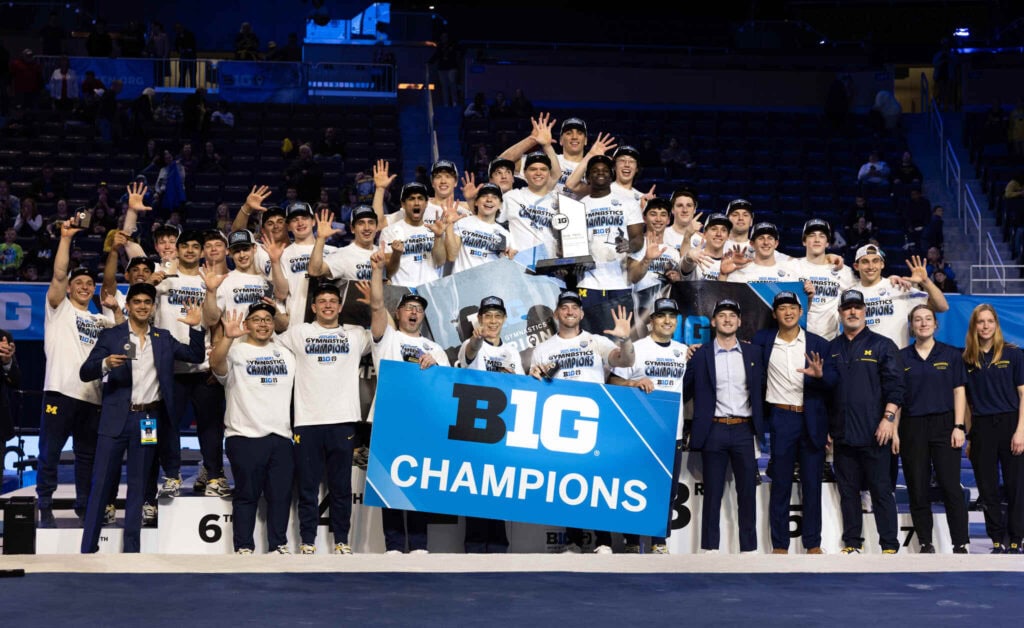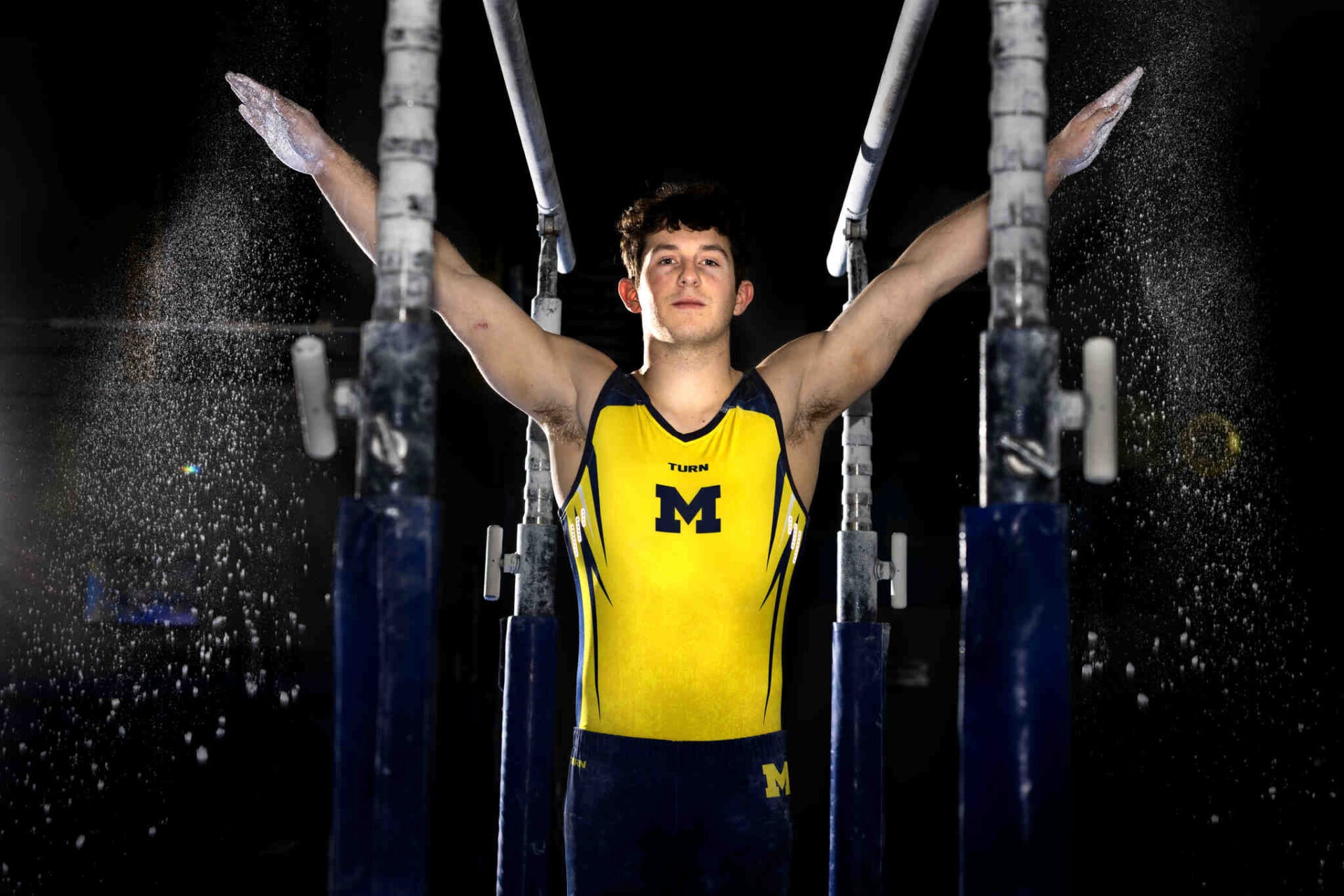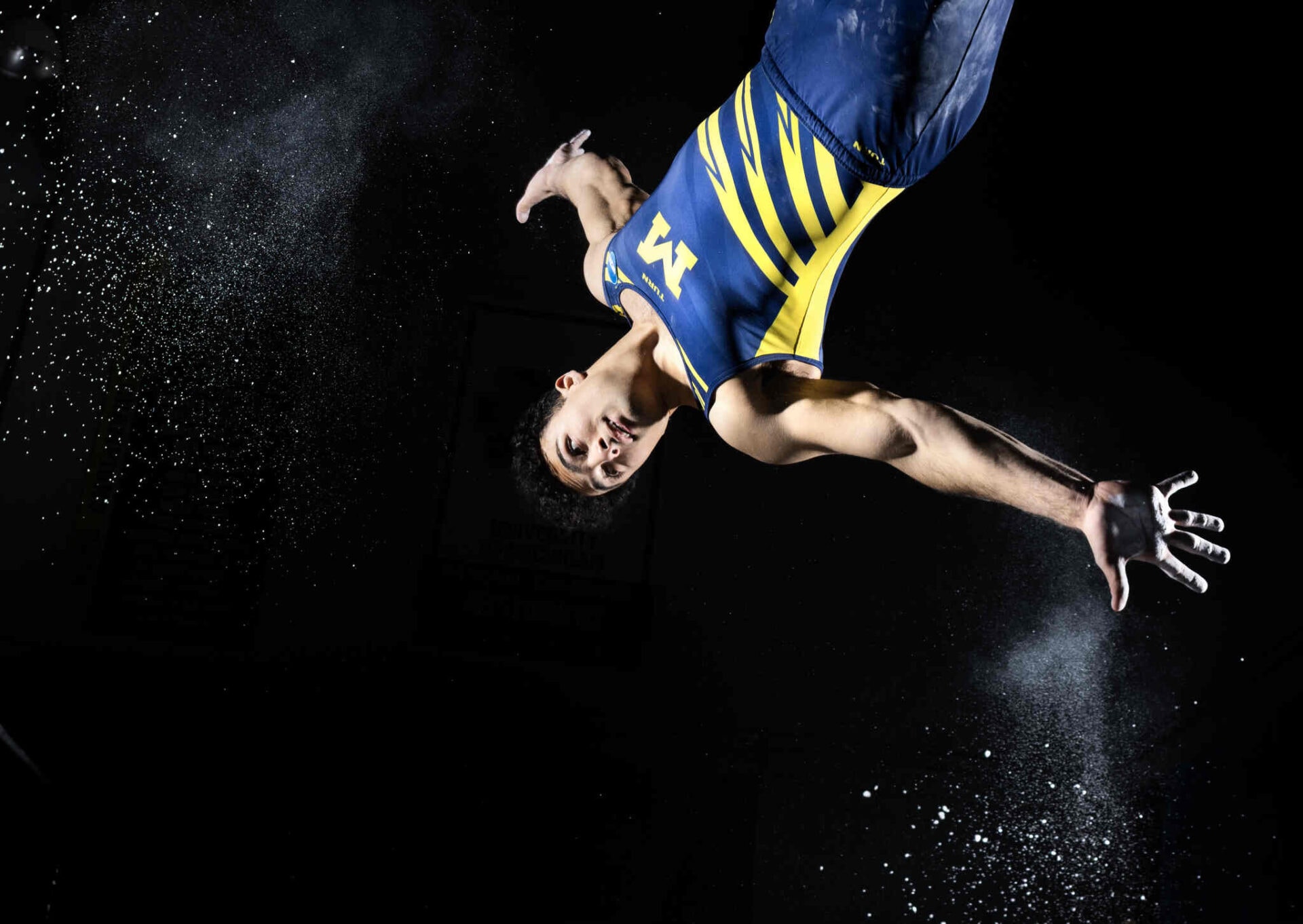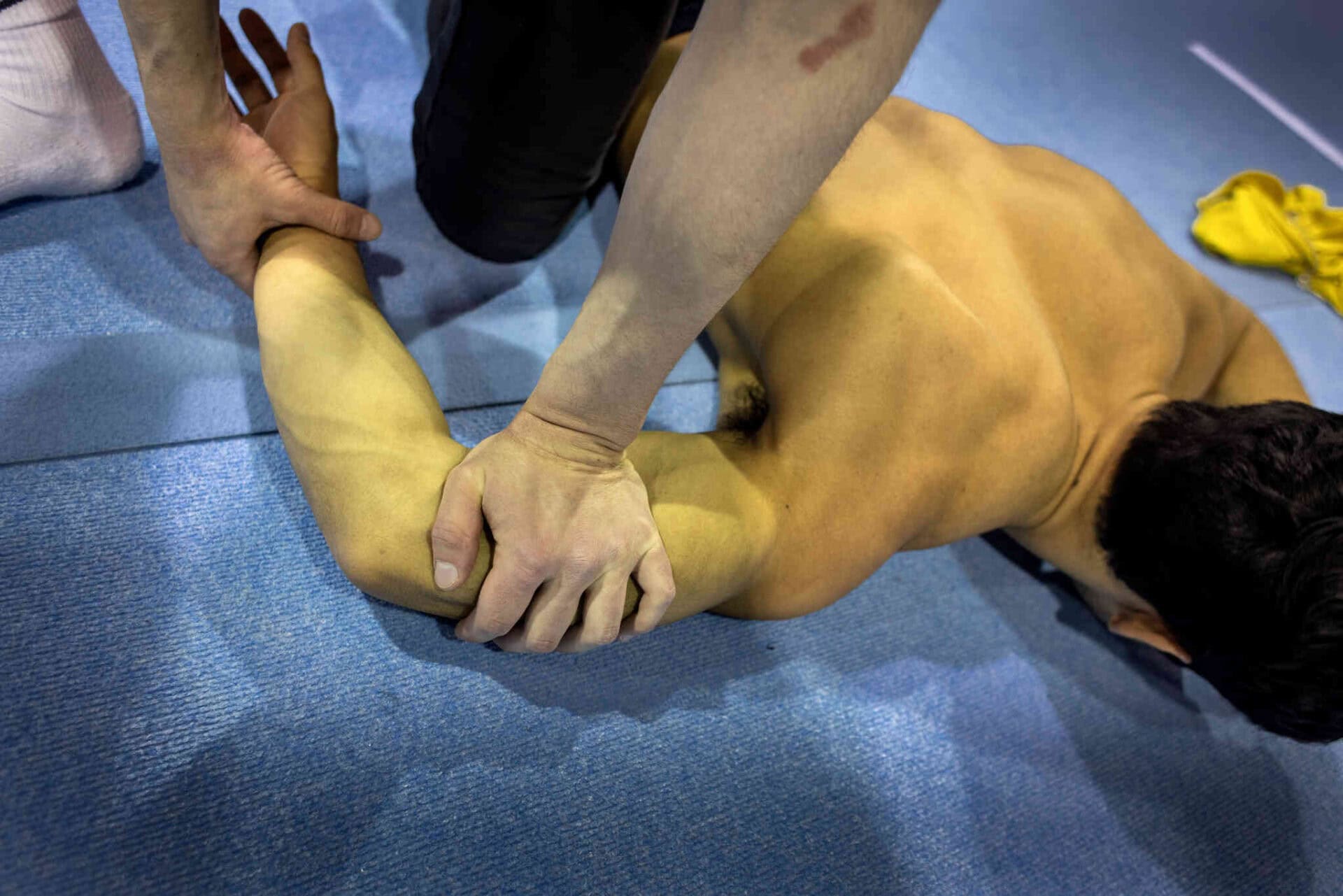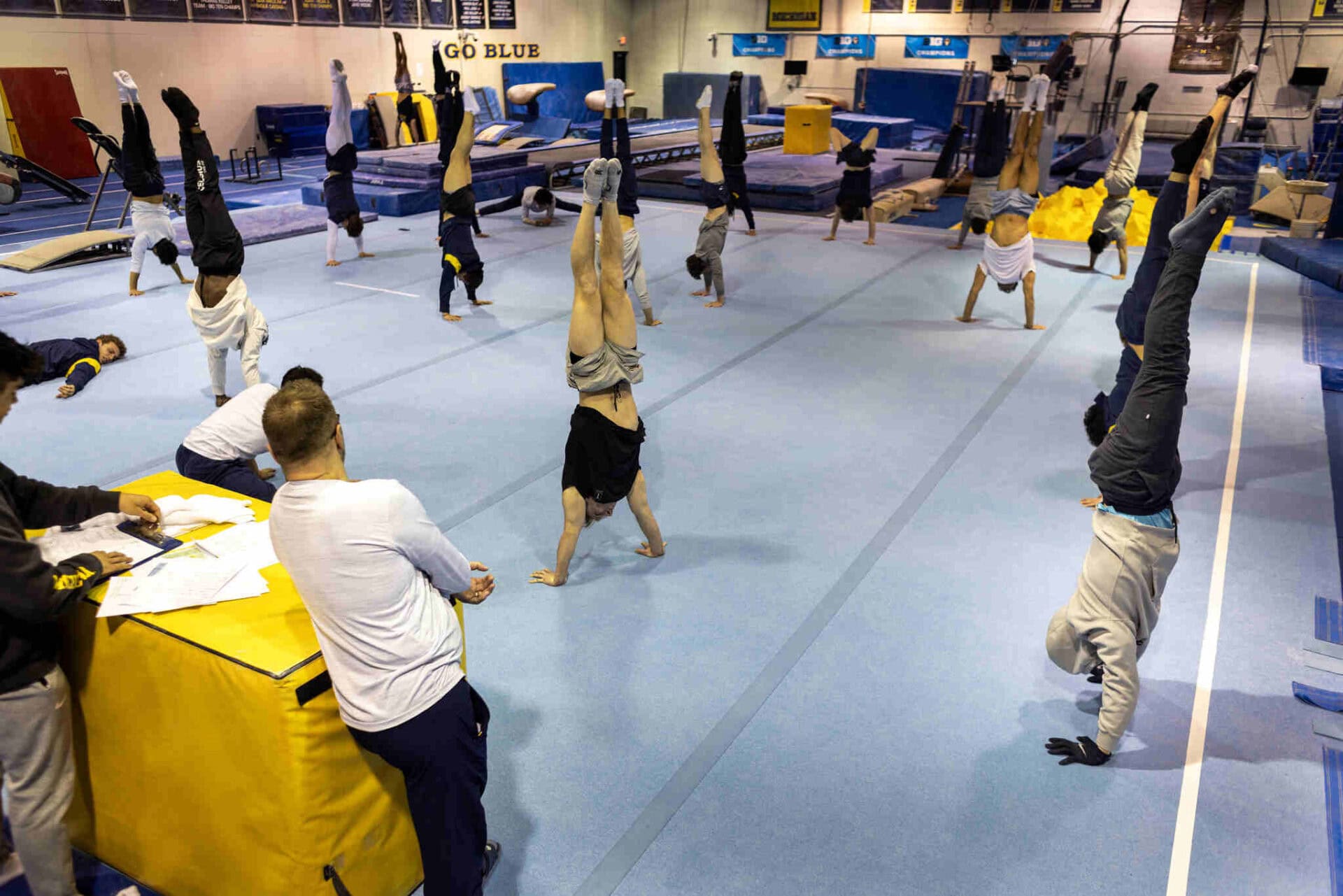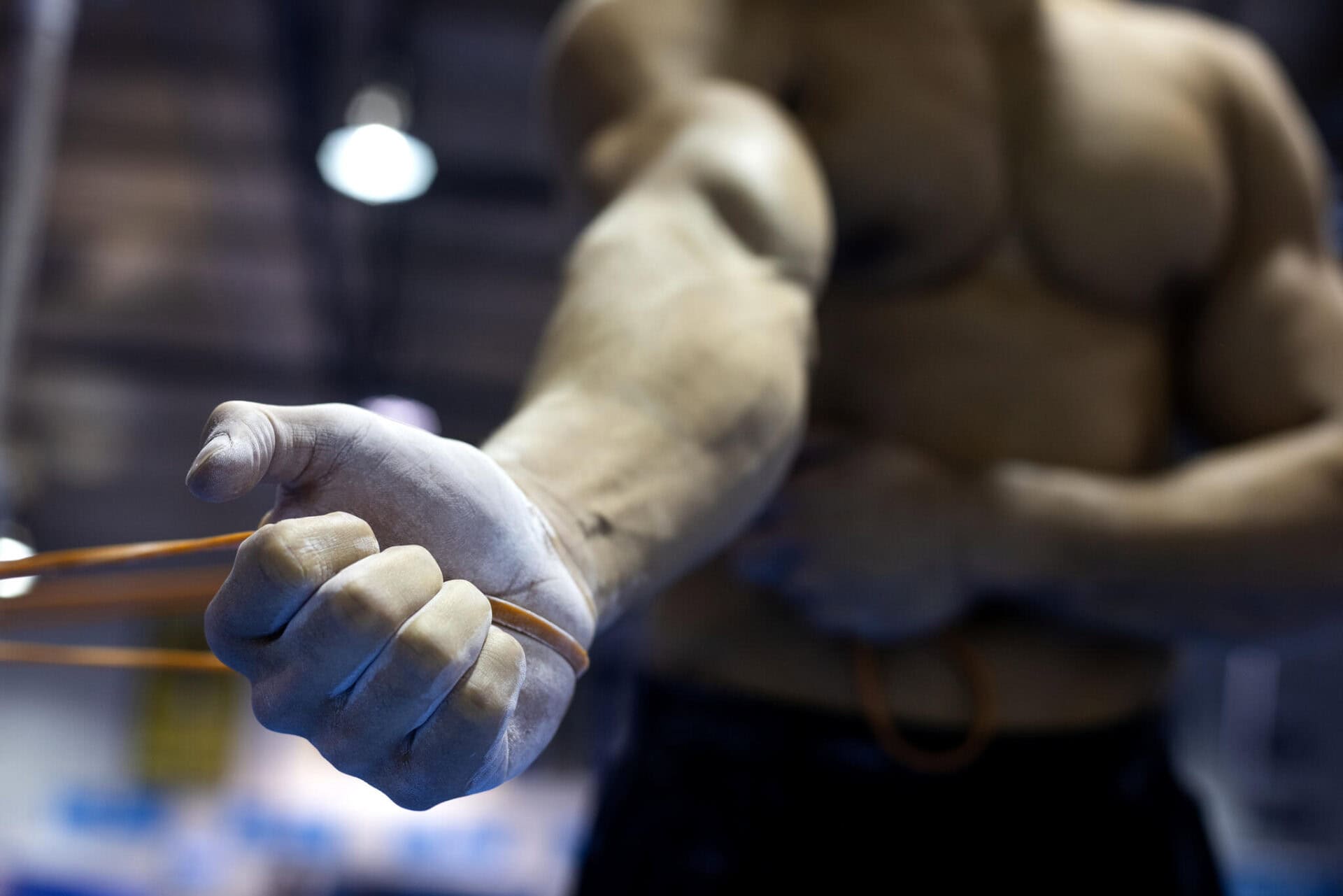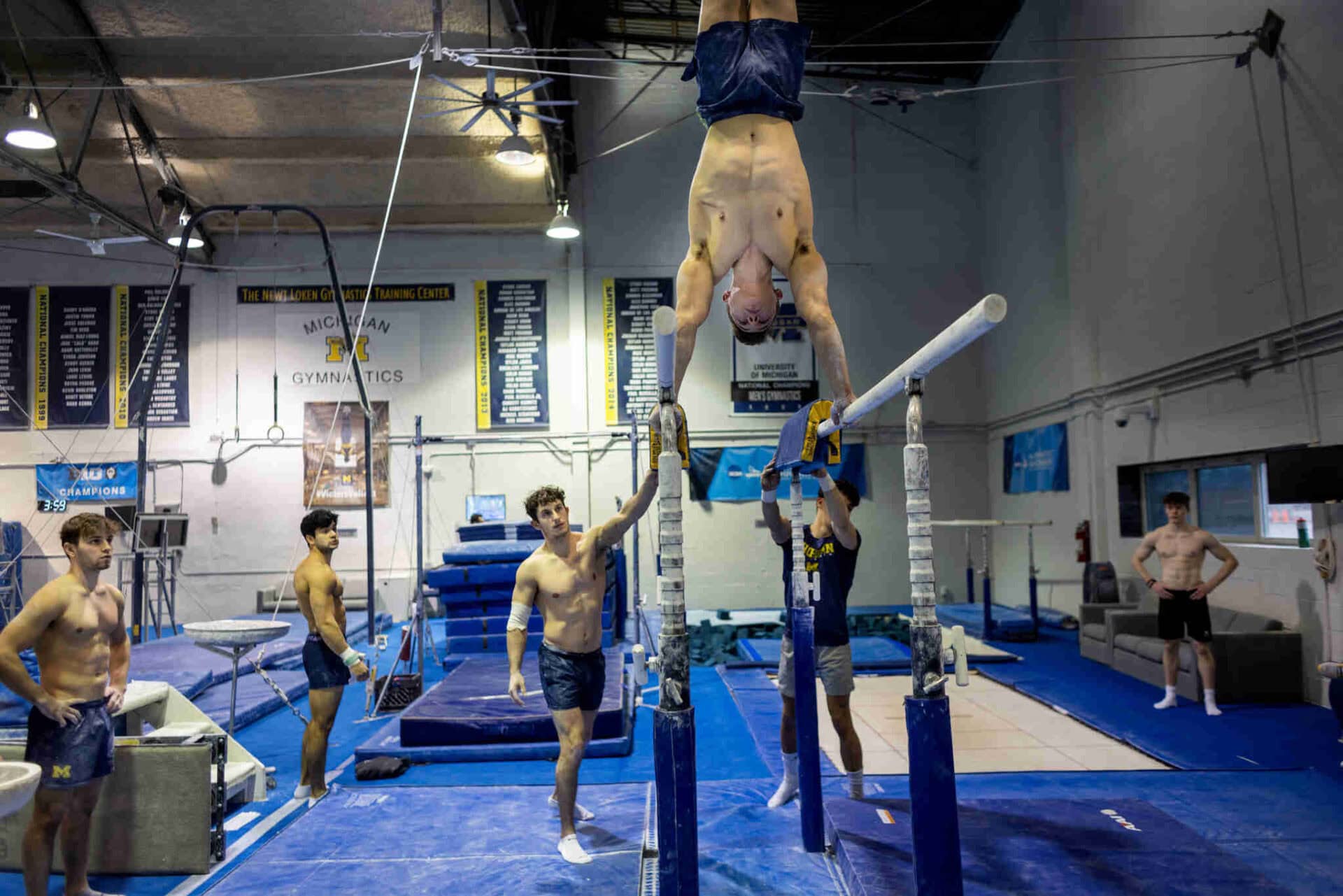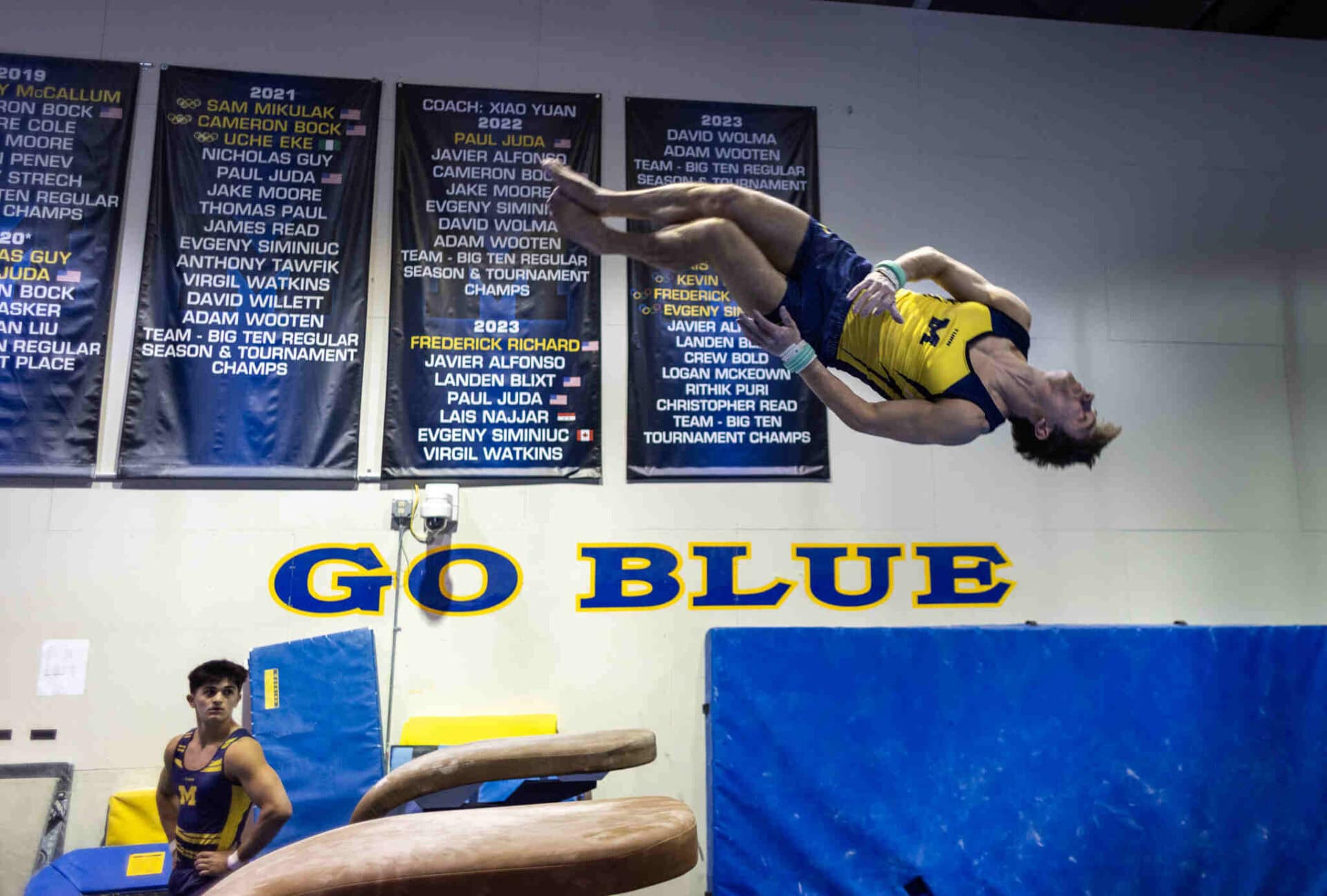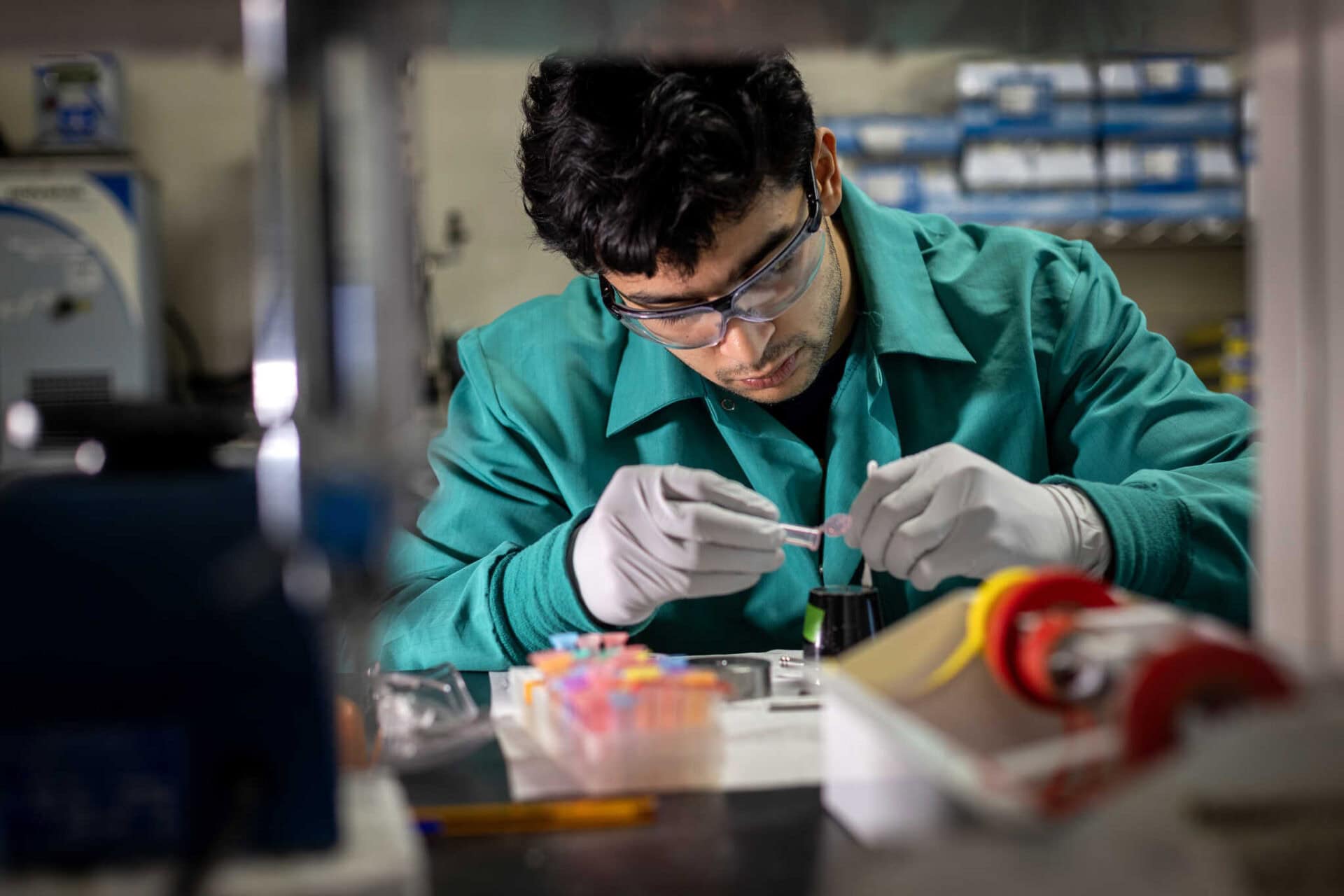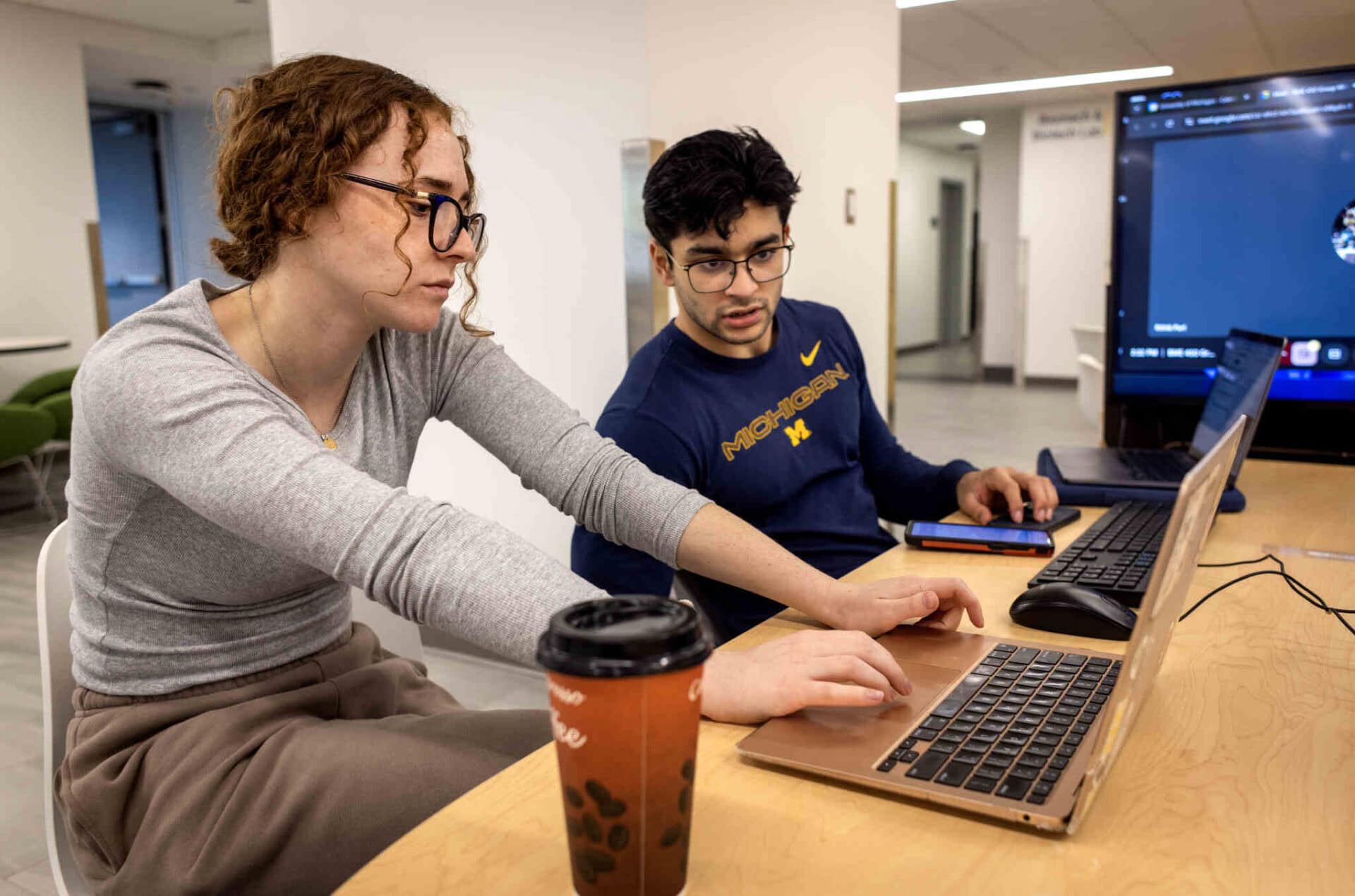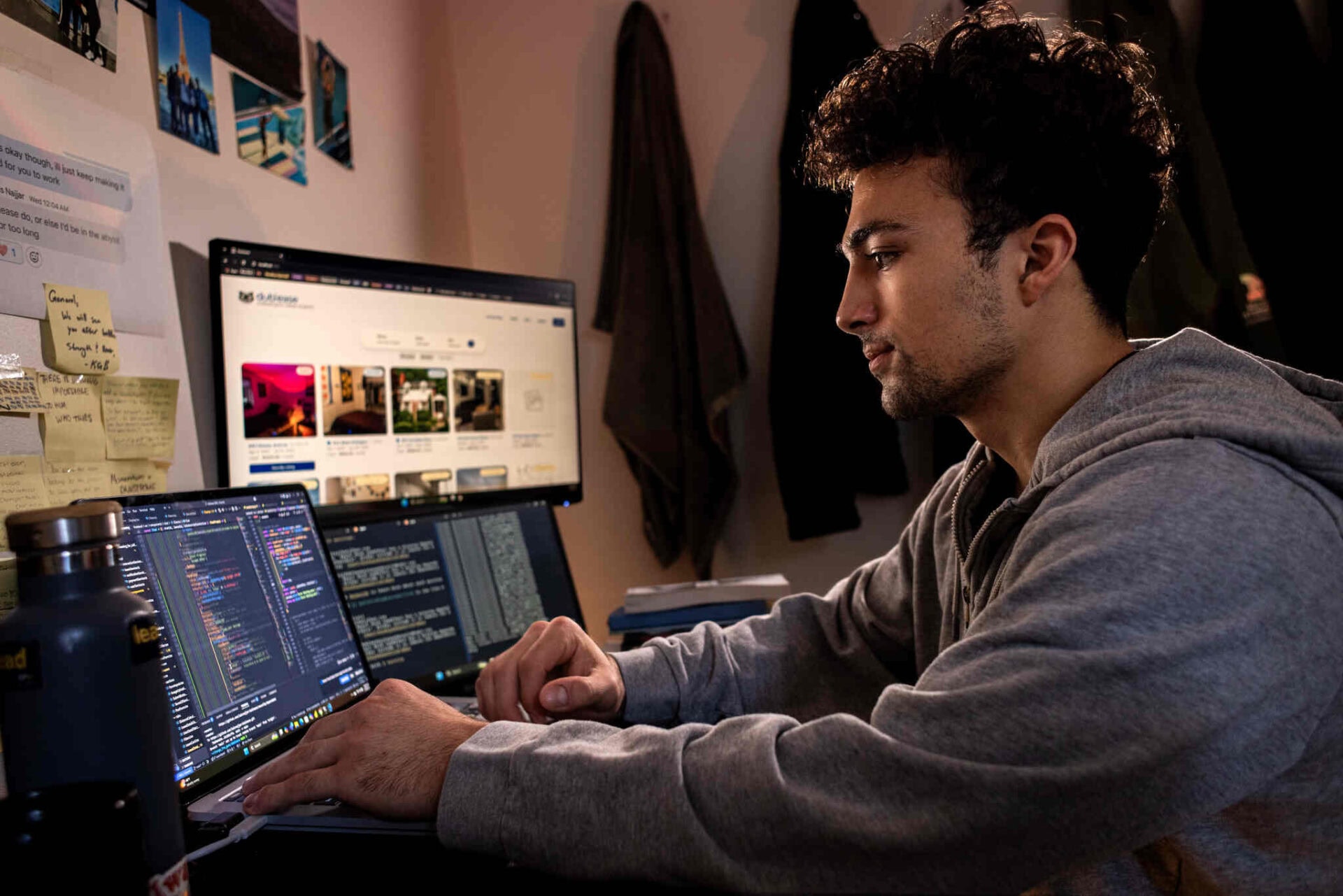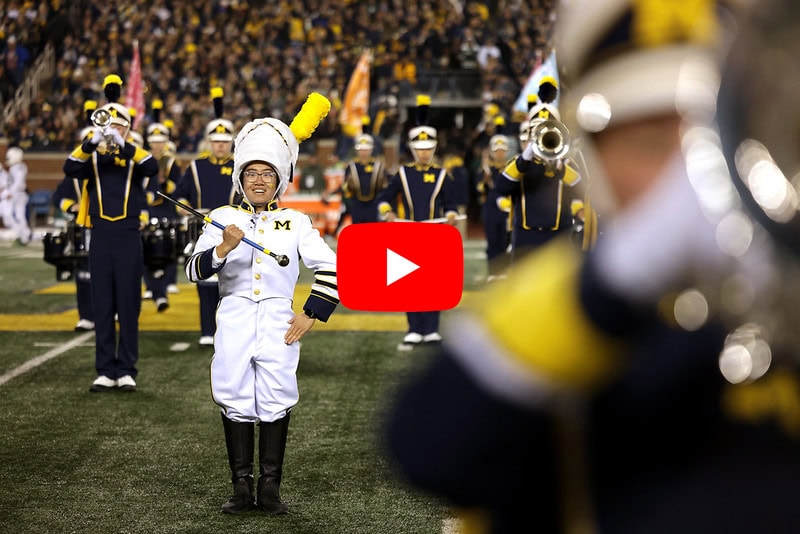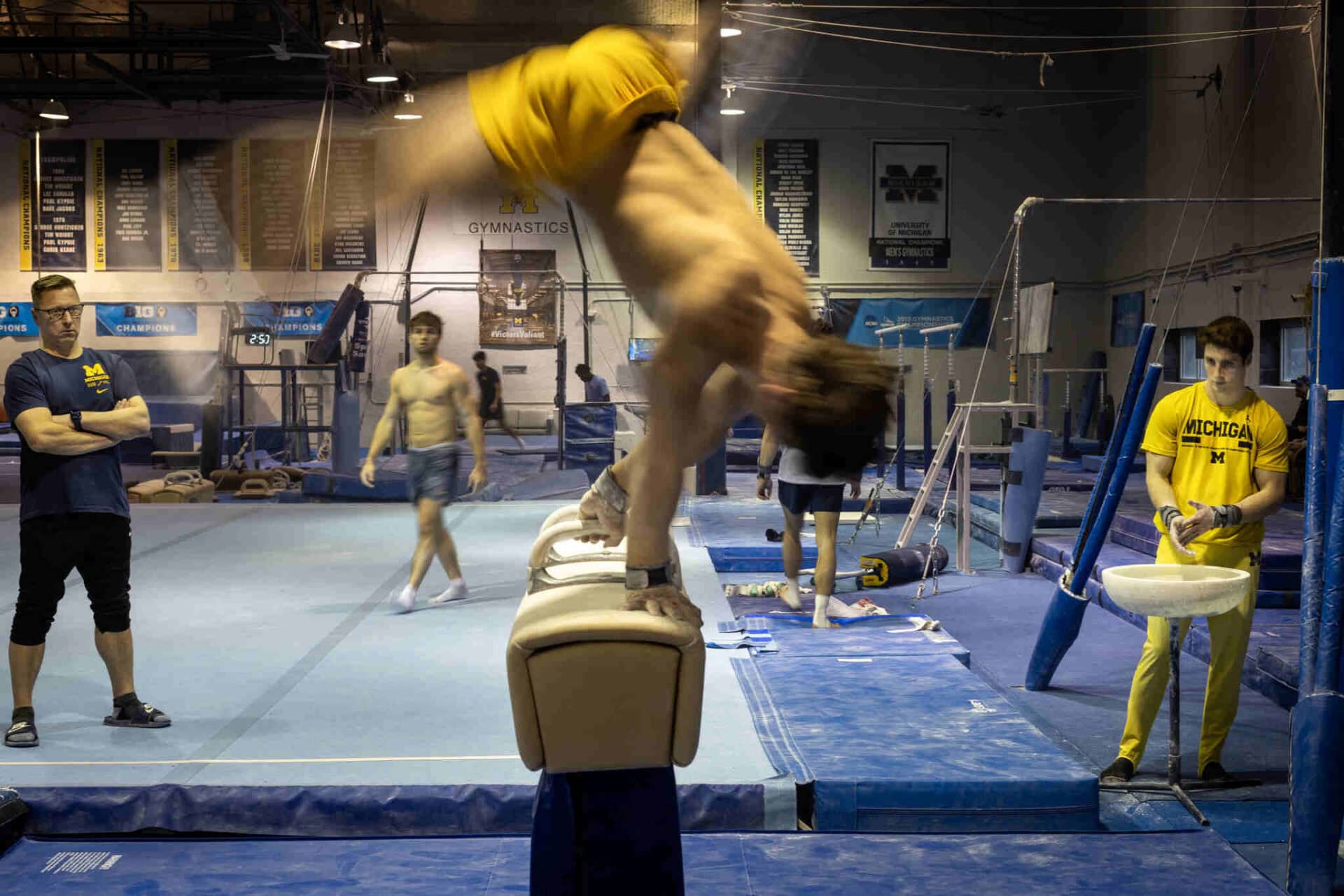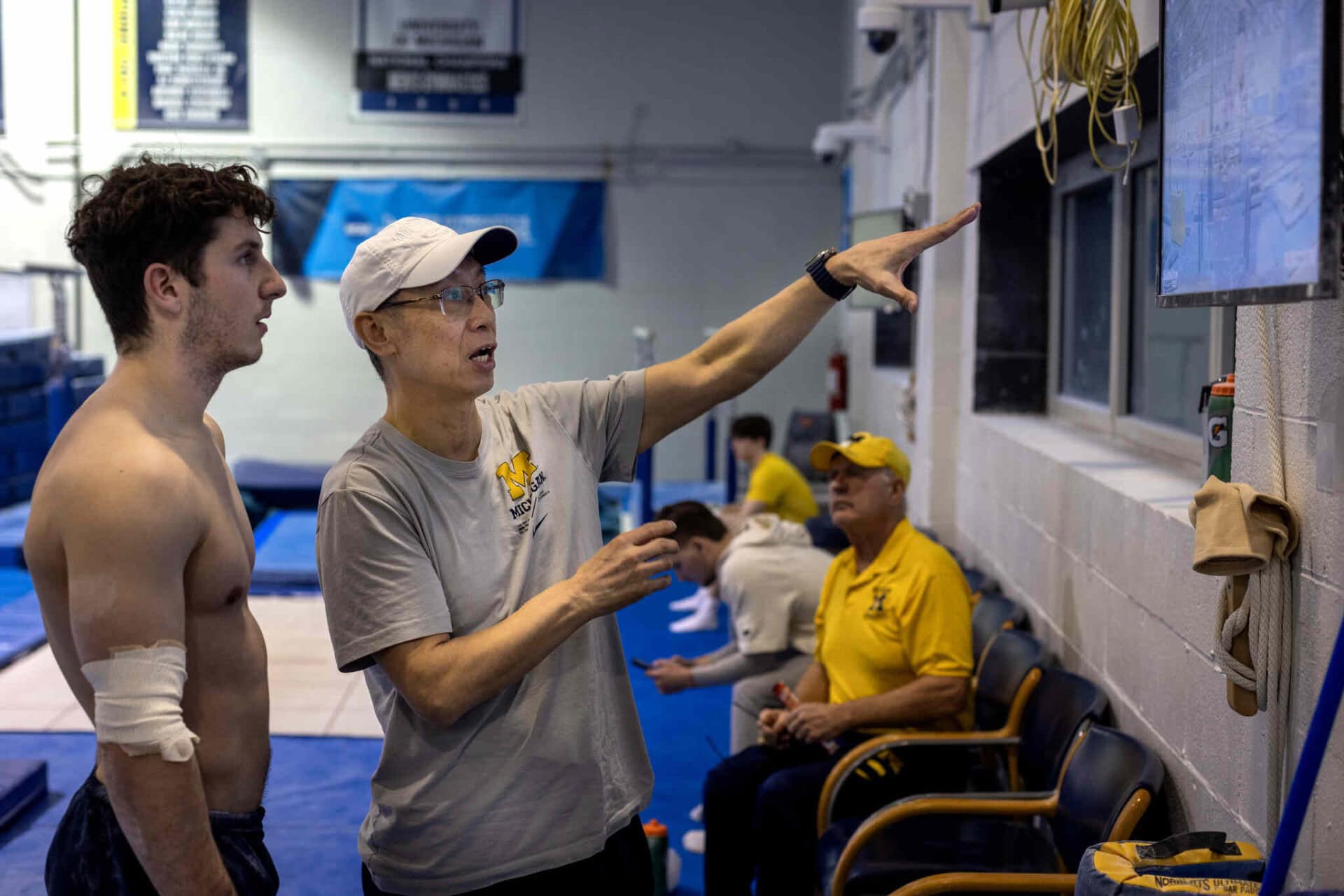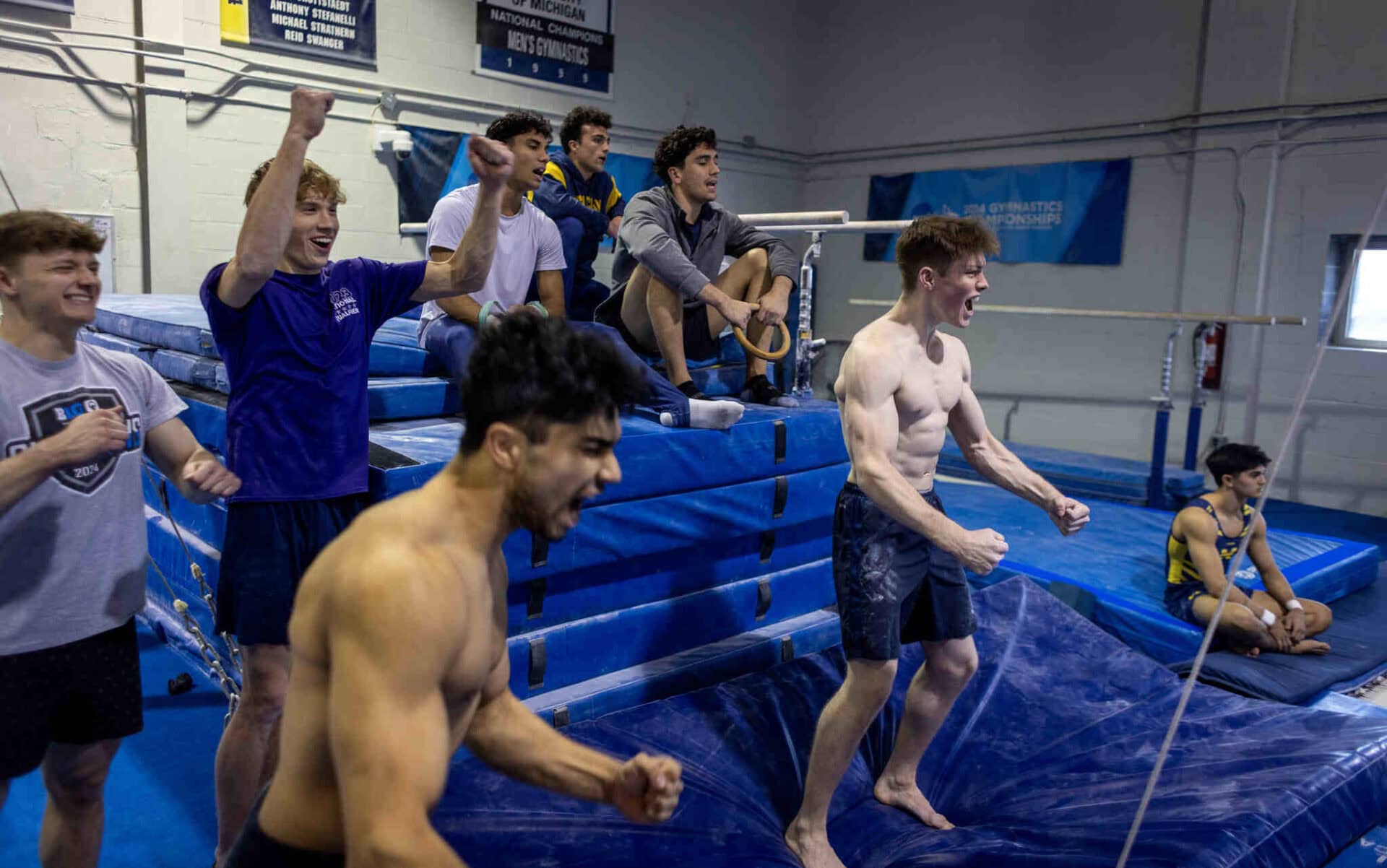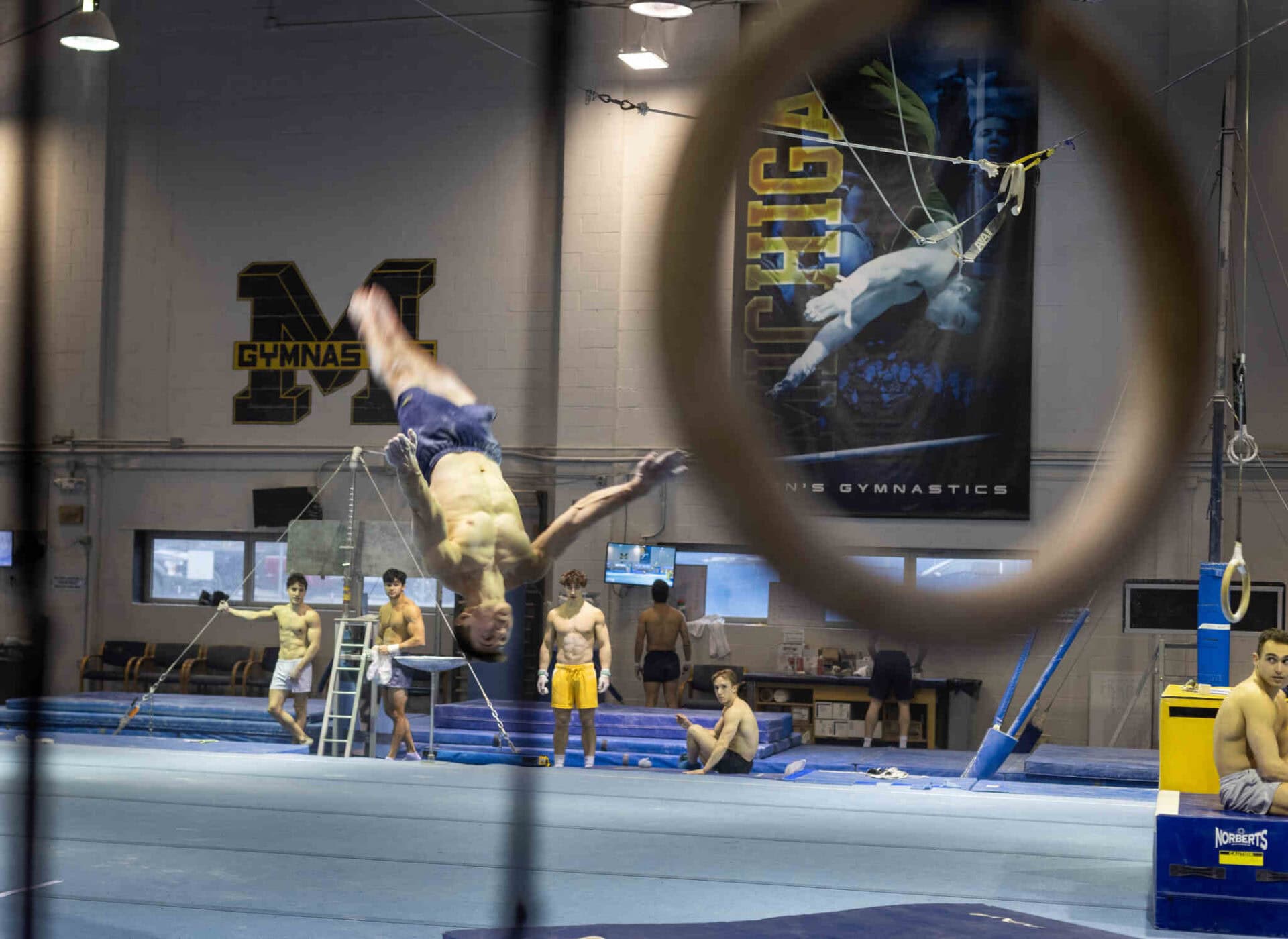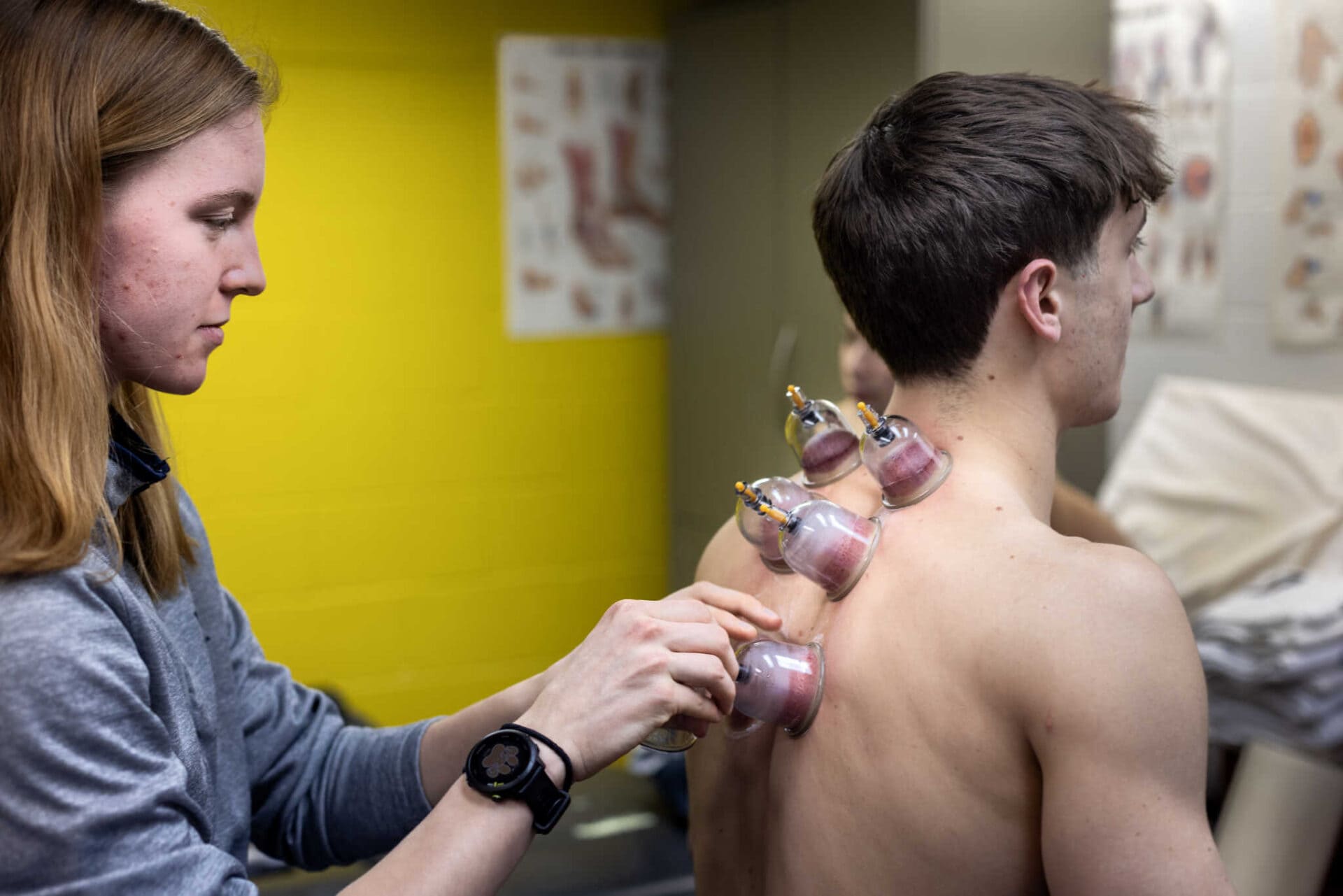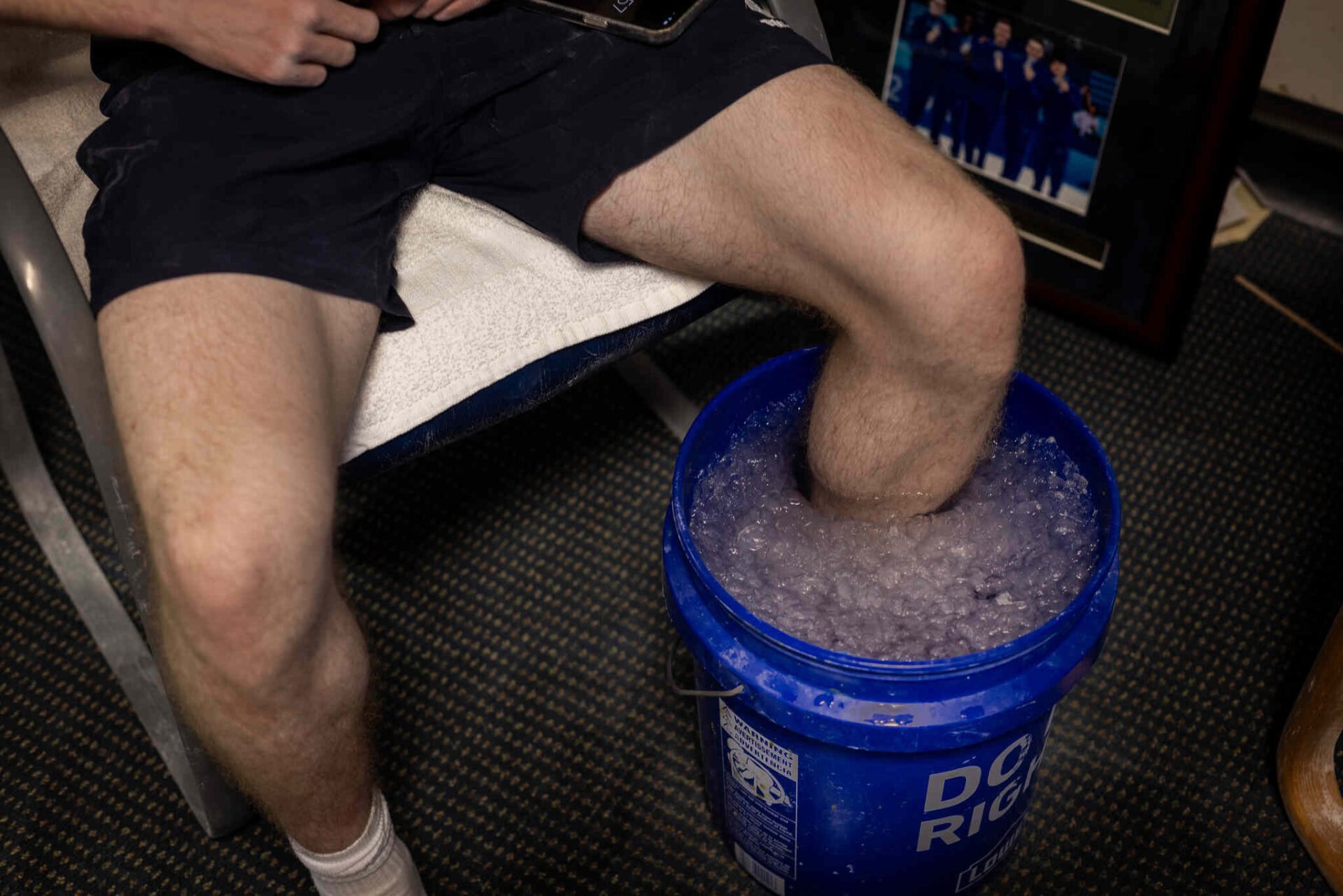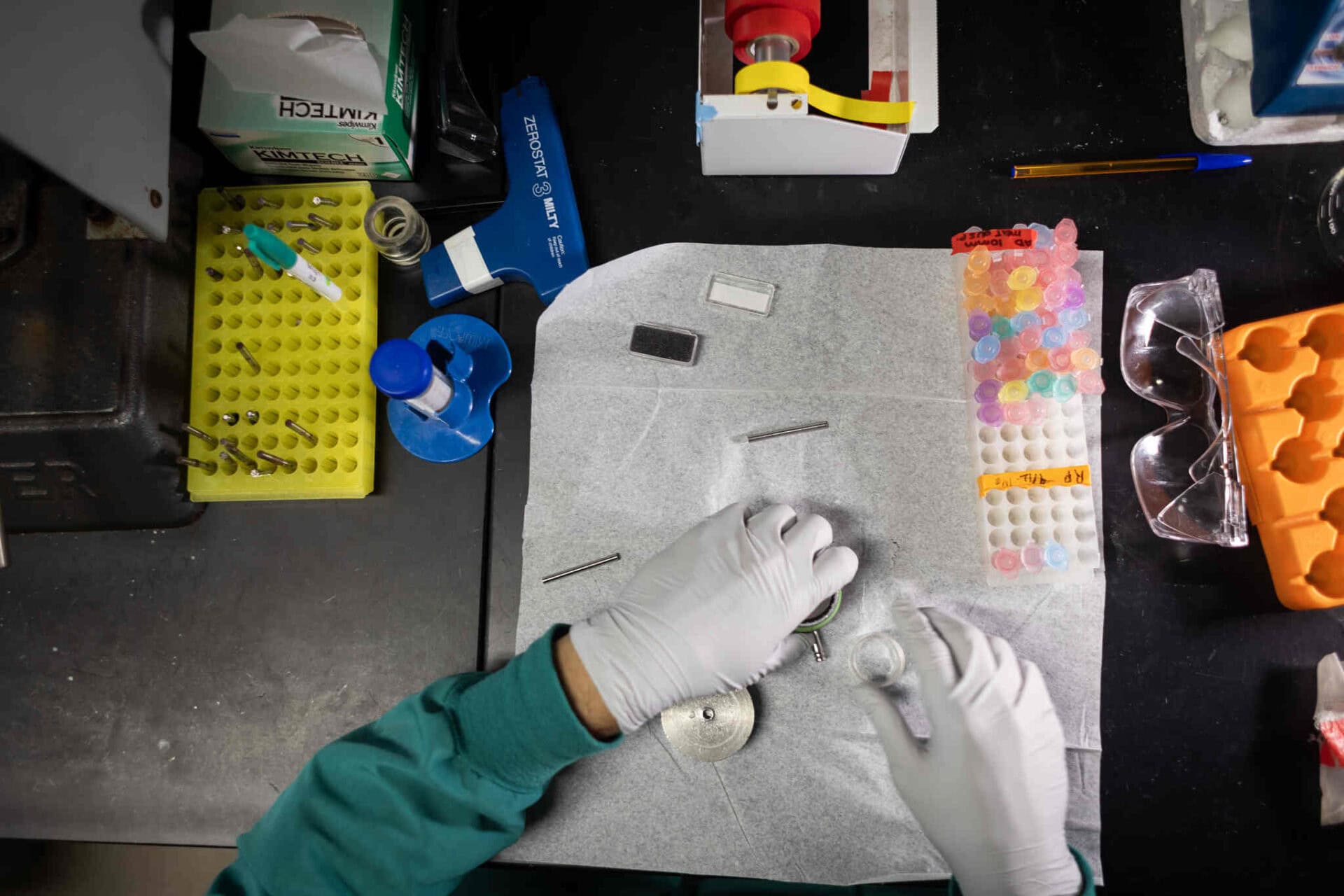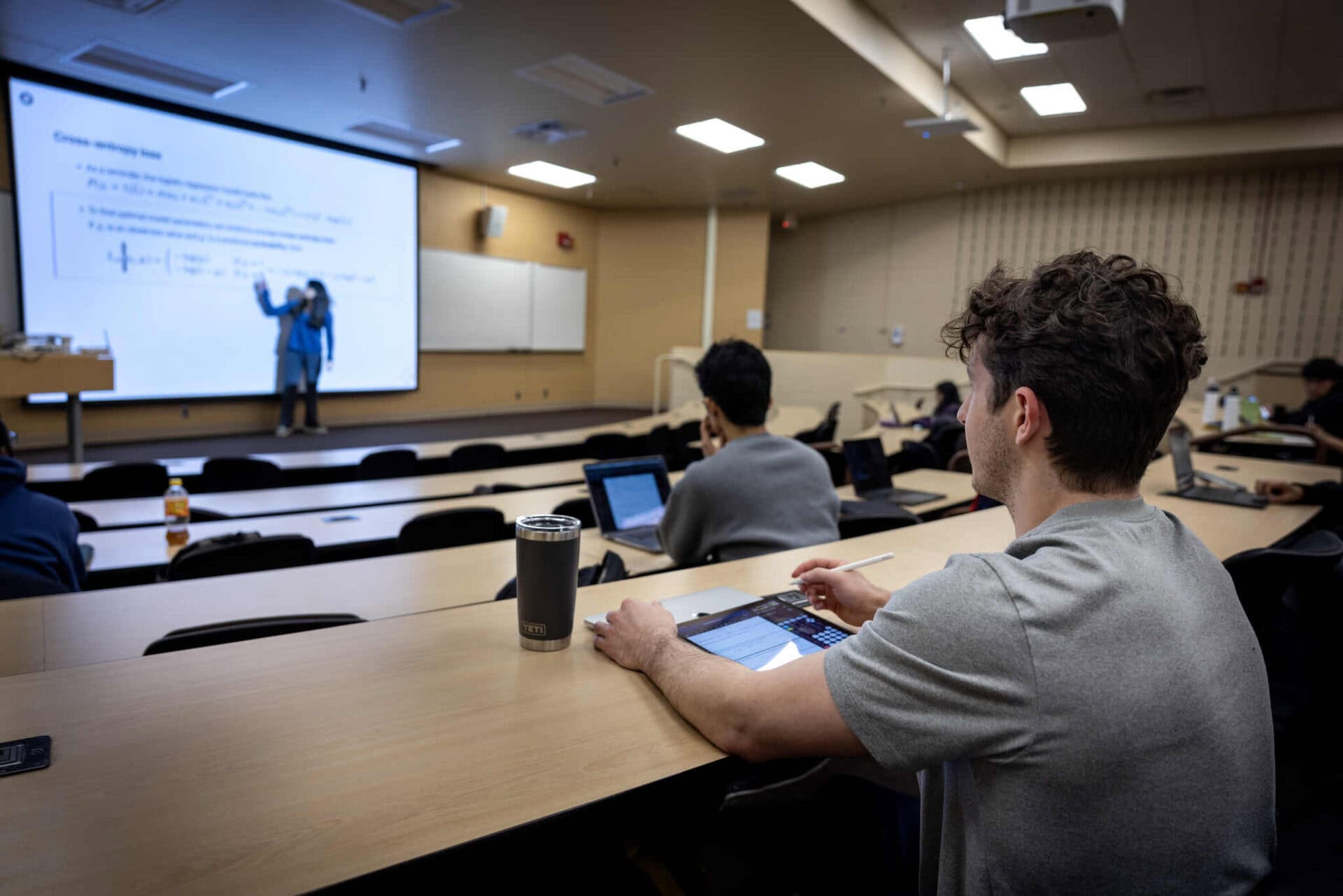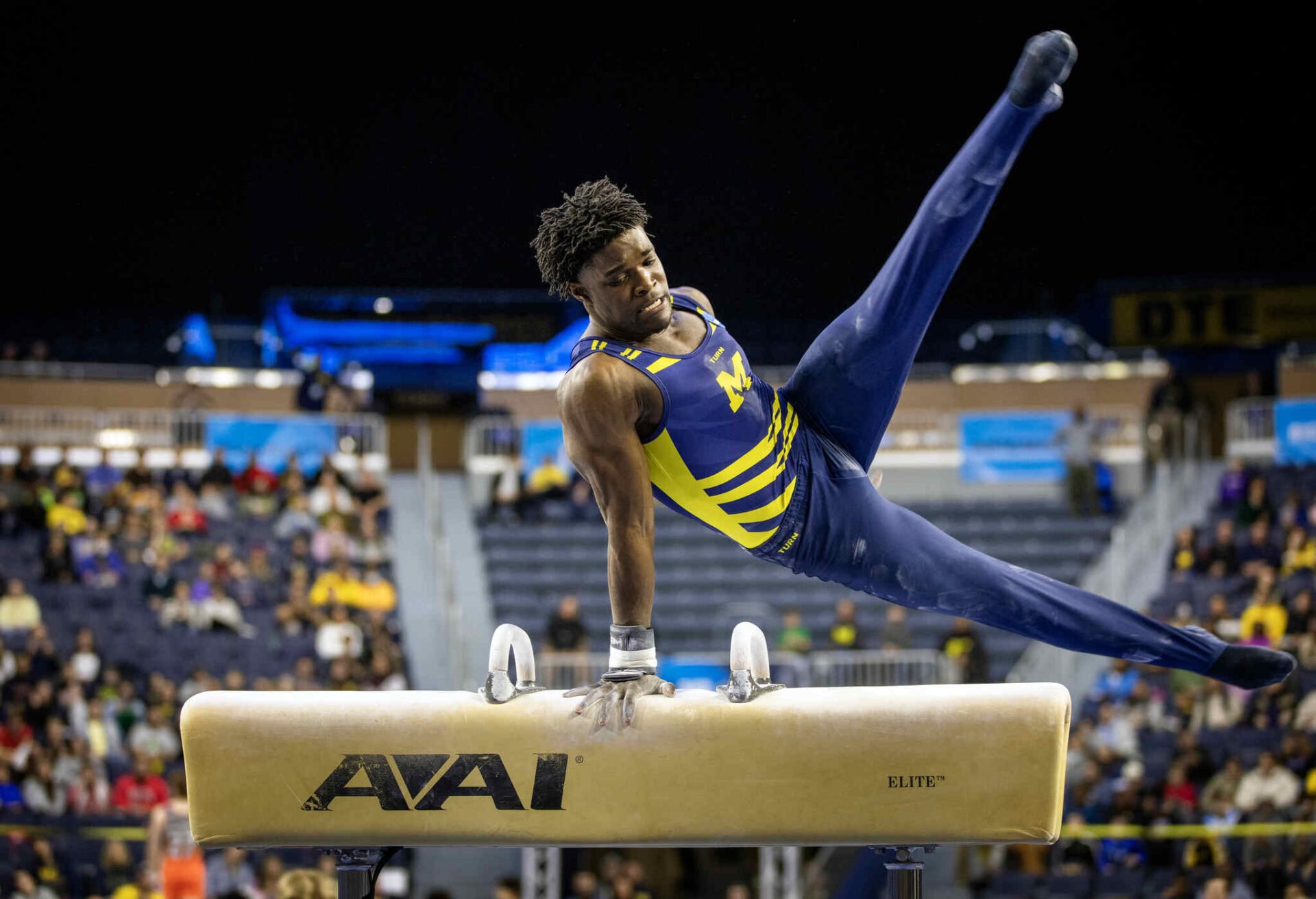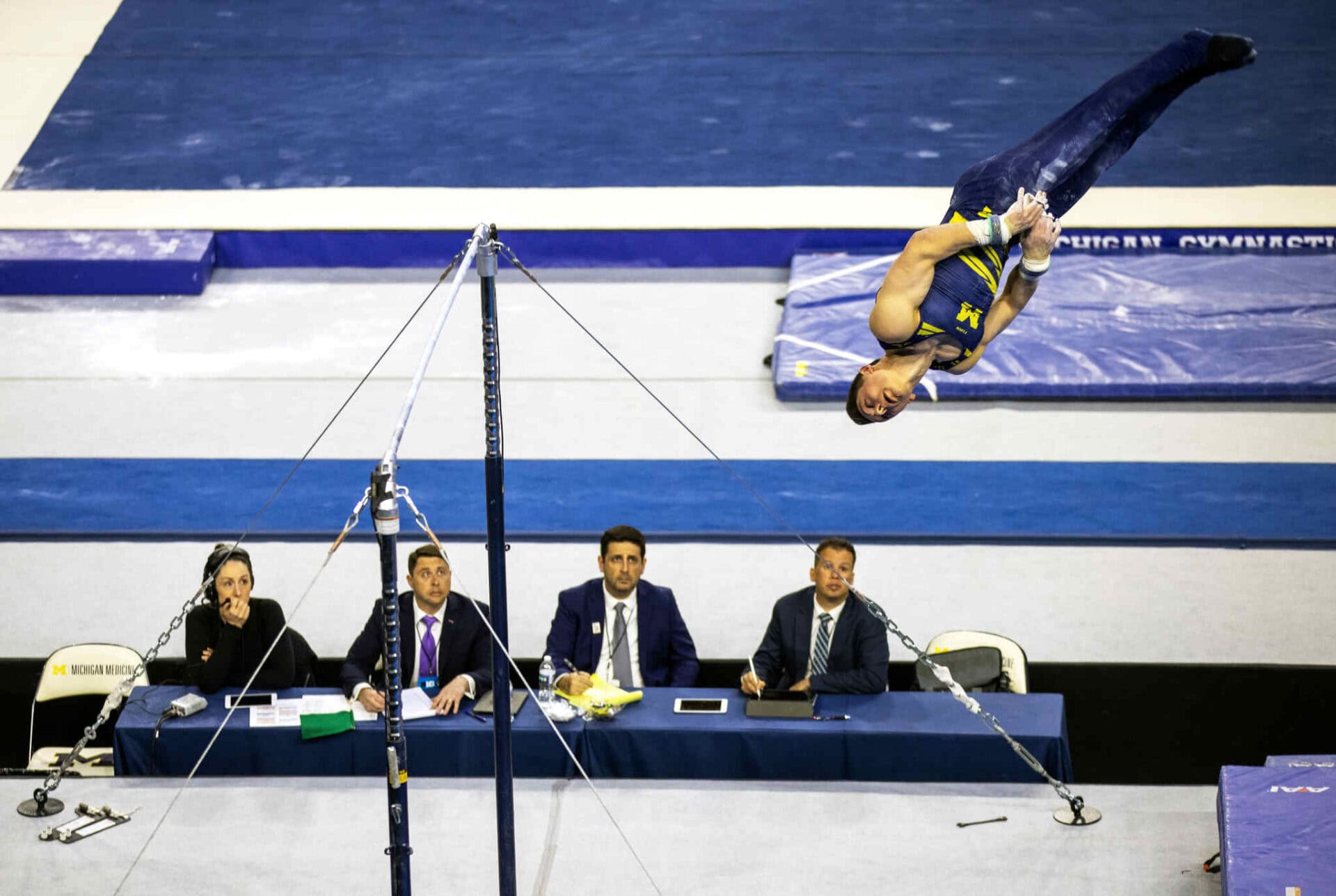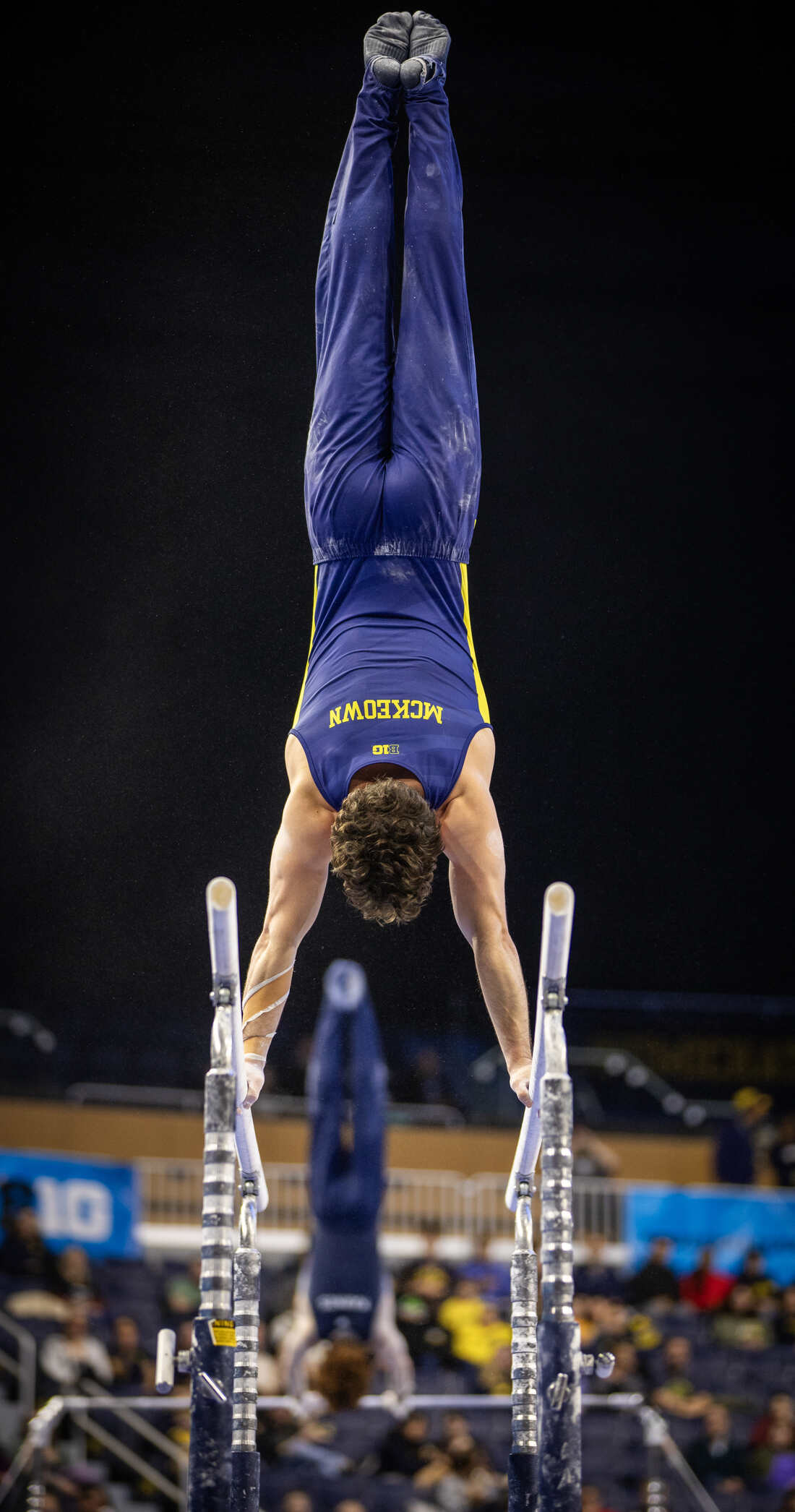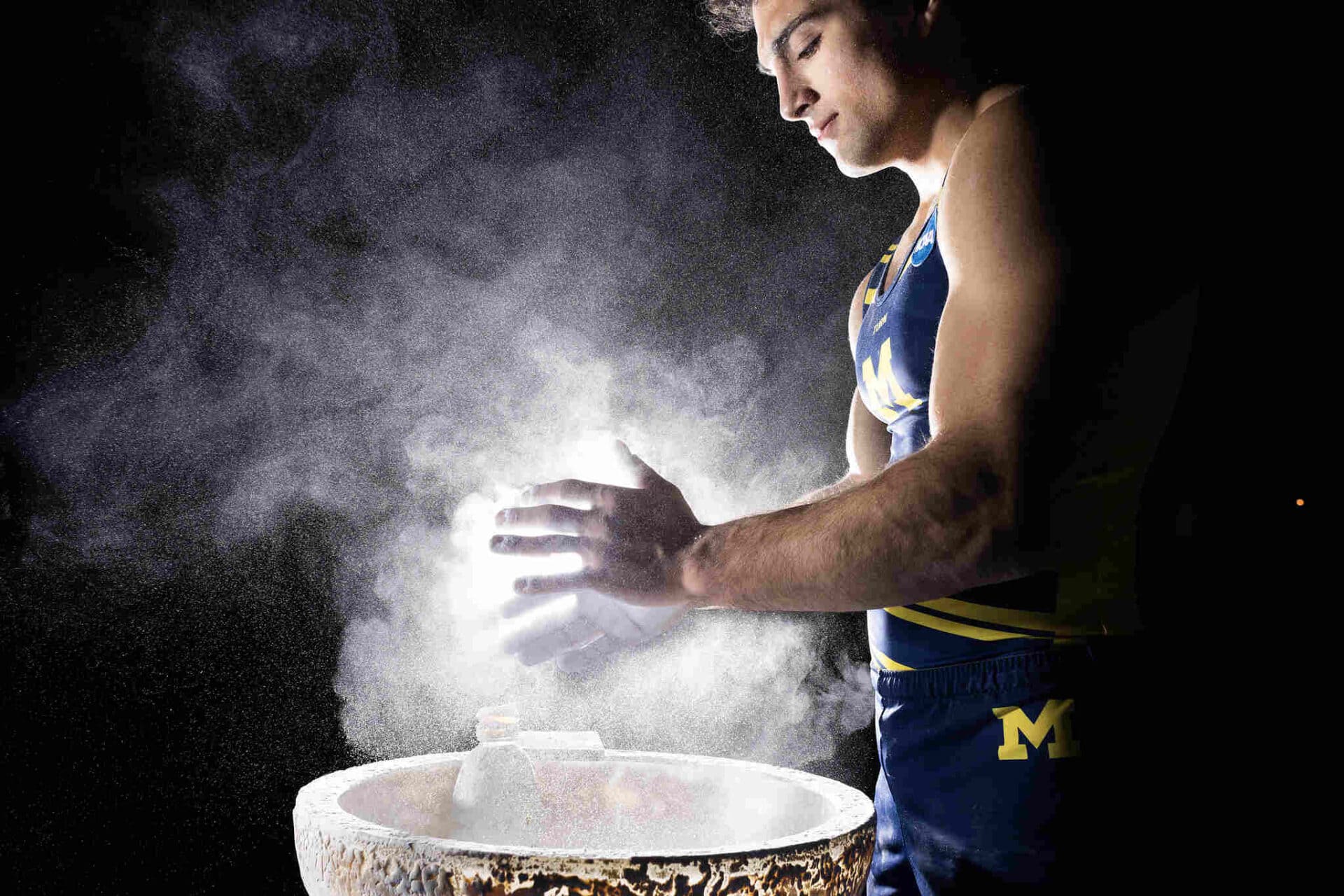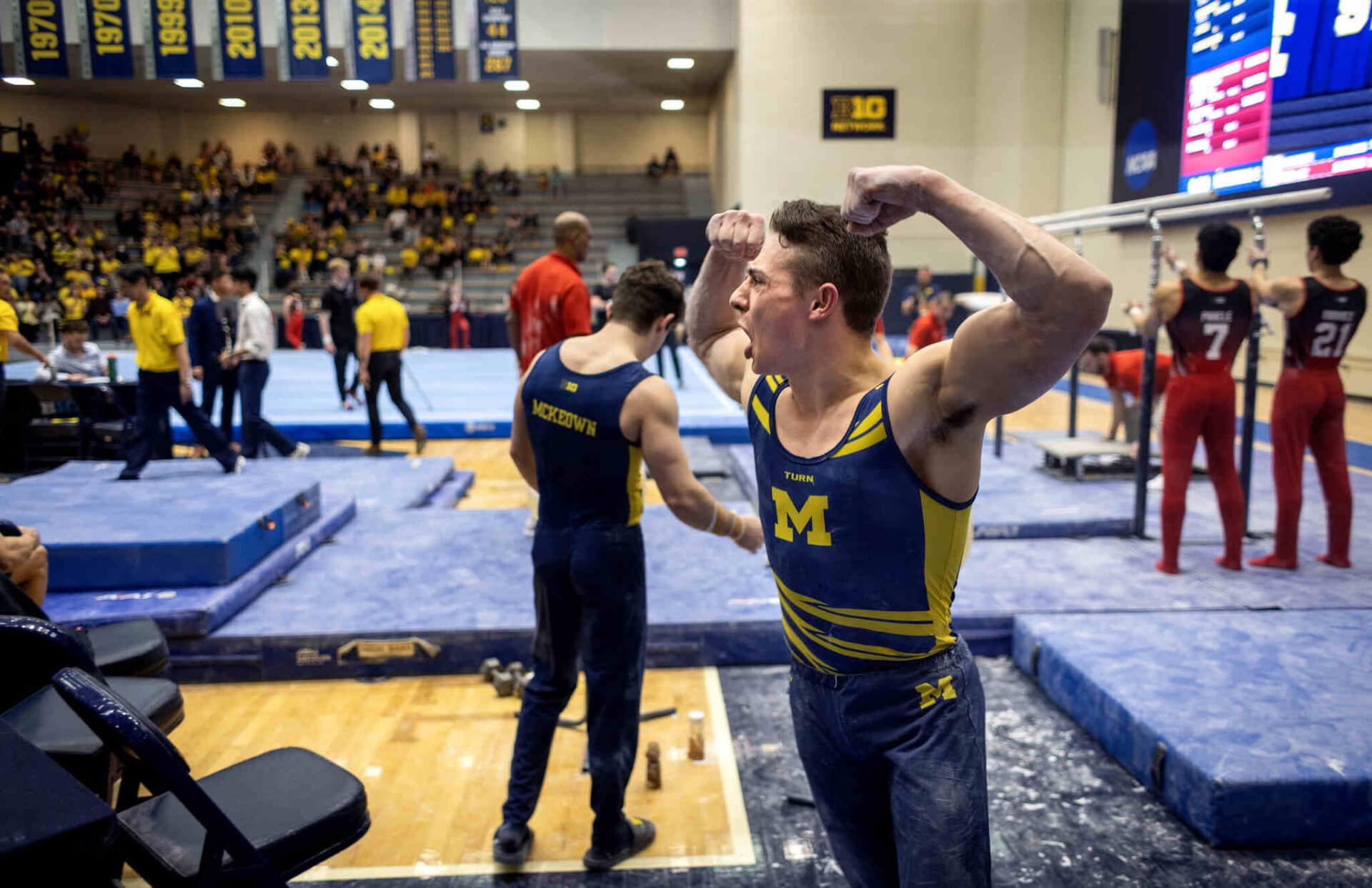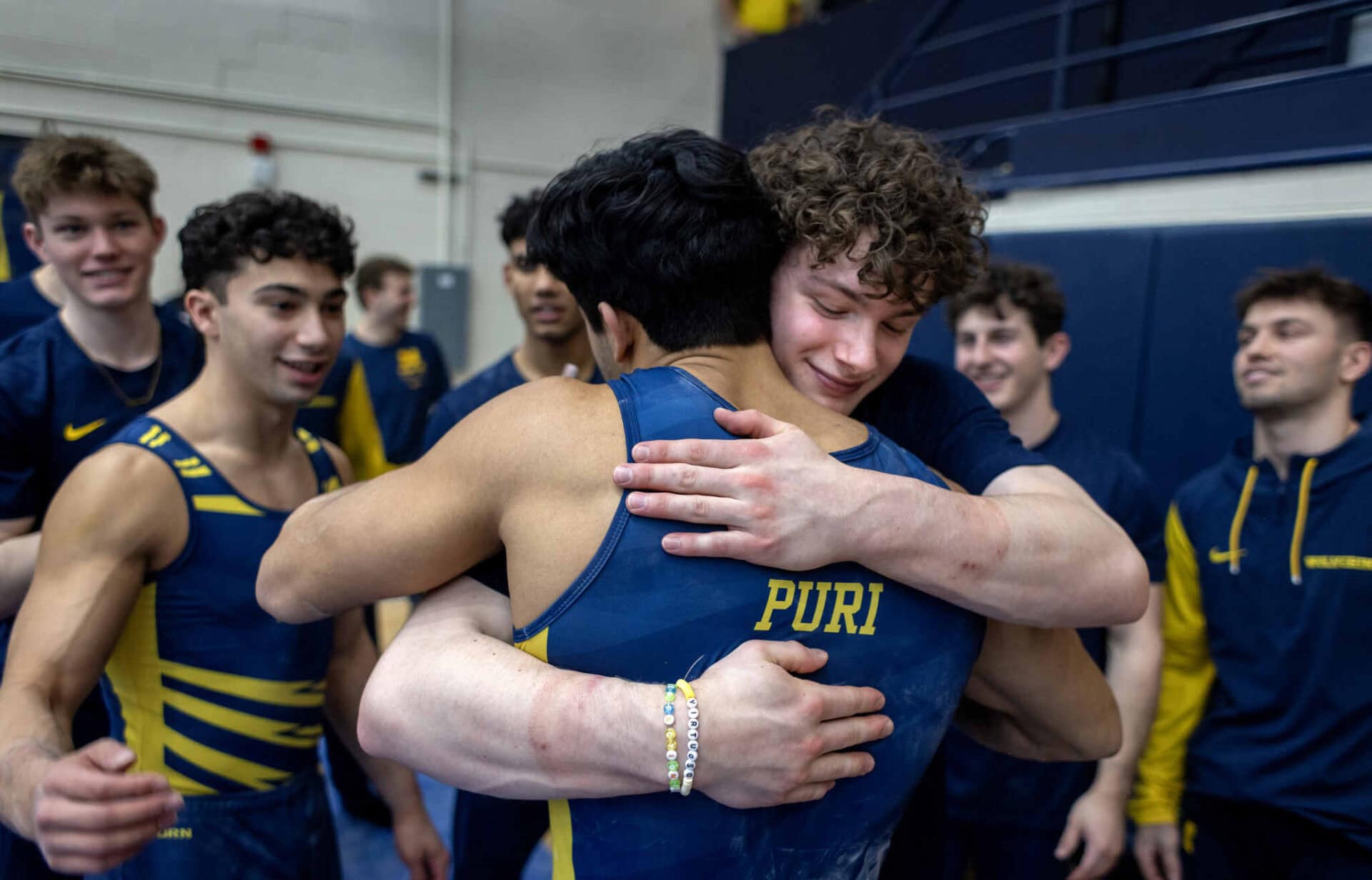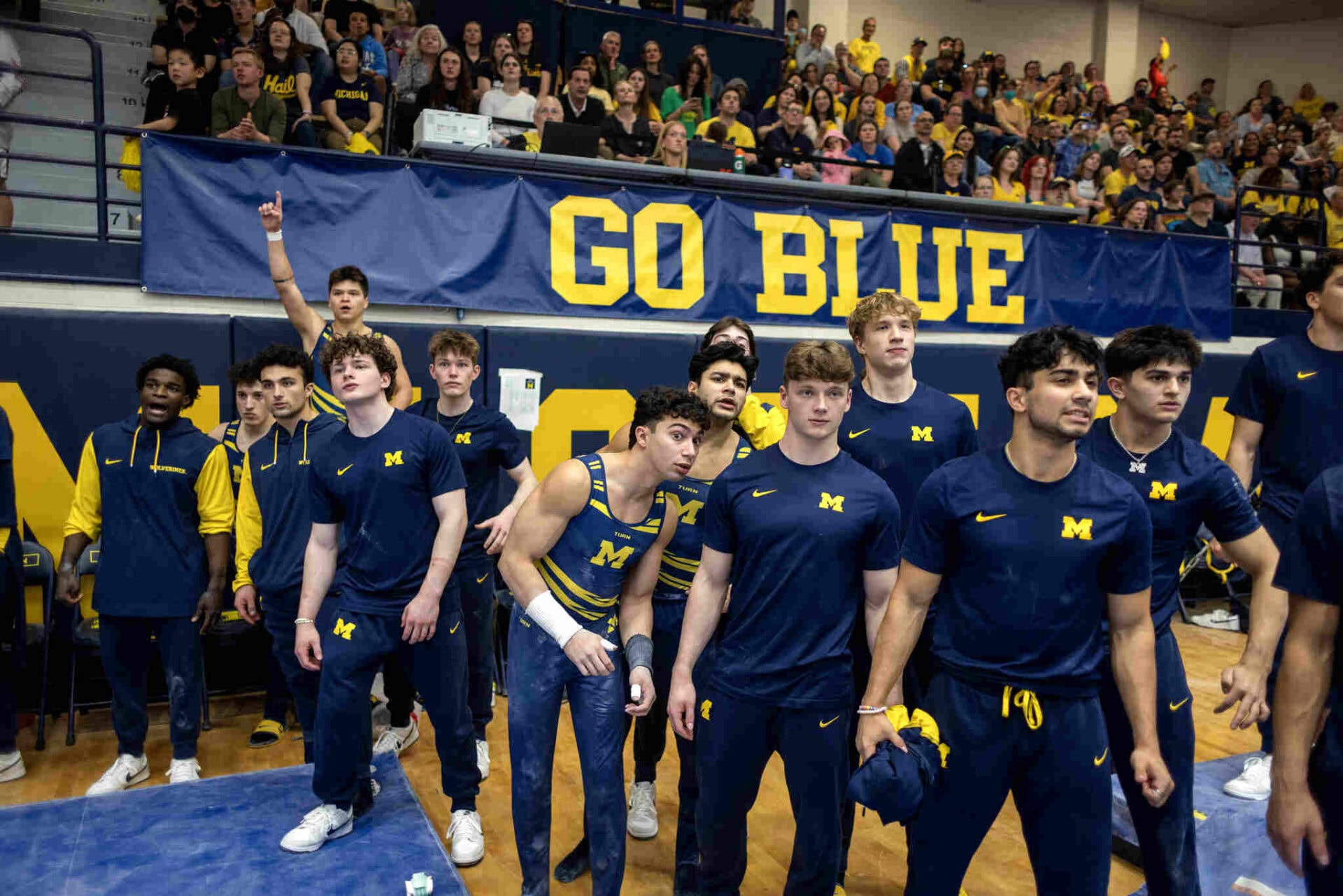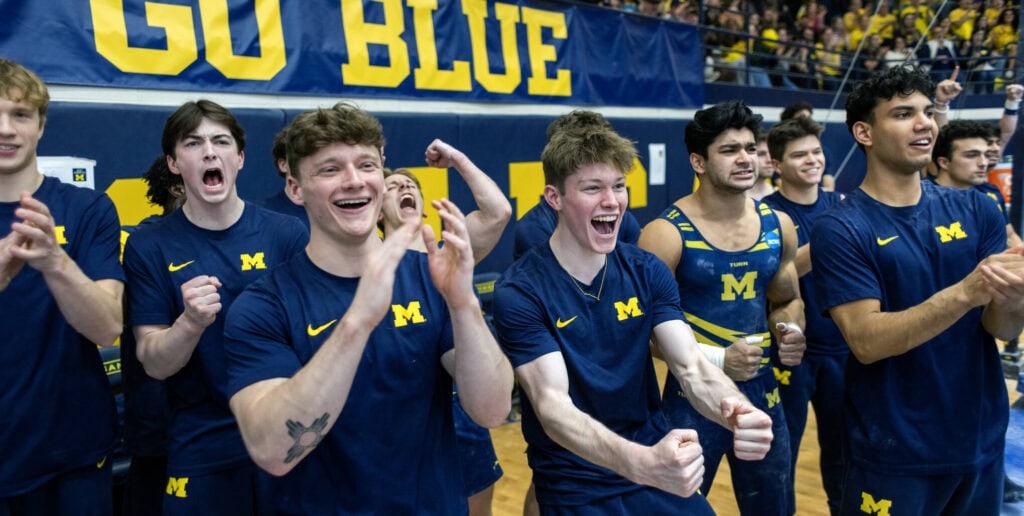
Precision in Motion
Bridging Engineering and Gymnastics
The University of Michigan Men’s Gymnastics team dominated the collegiate scene in 2025, capturing both the NCAA Championship and their fifth consecutive Big Ten title. They closed out the season ranked first in the nation. At the heart of this success were three engineering seniors who balanced the rigors of demanding academic schedules with intense training to help lead their team to glory.
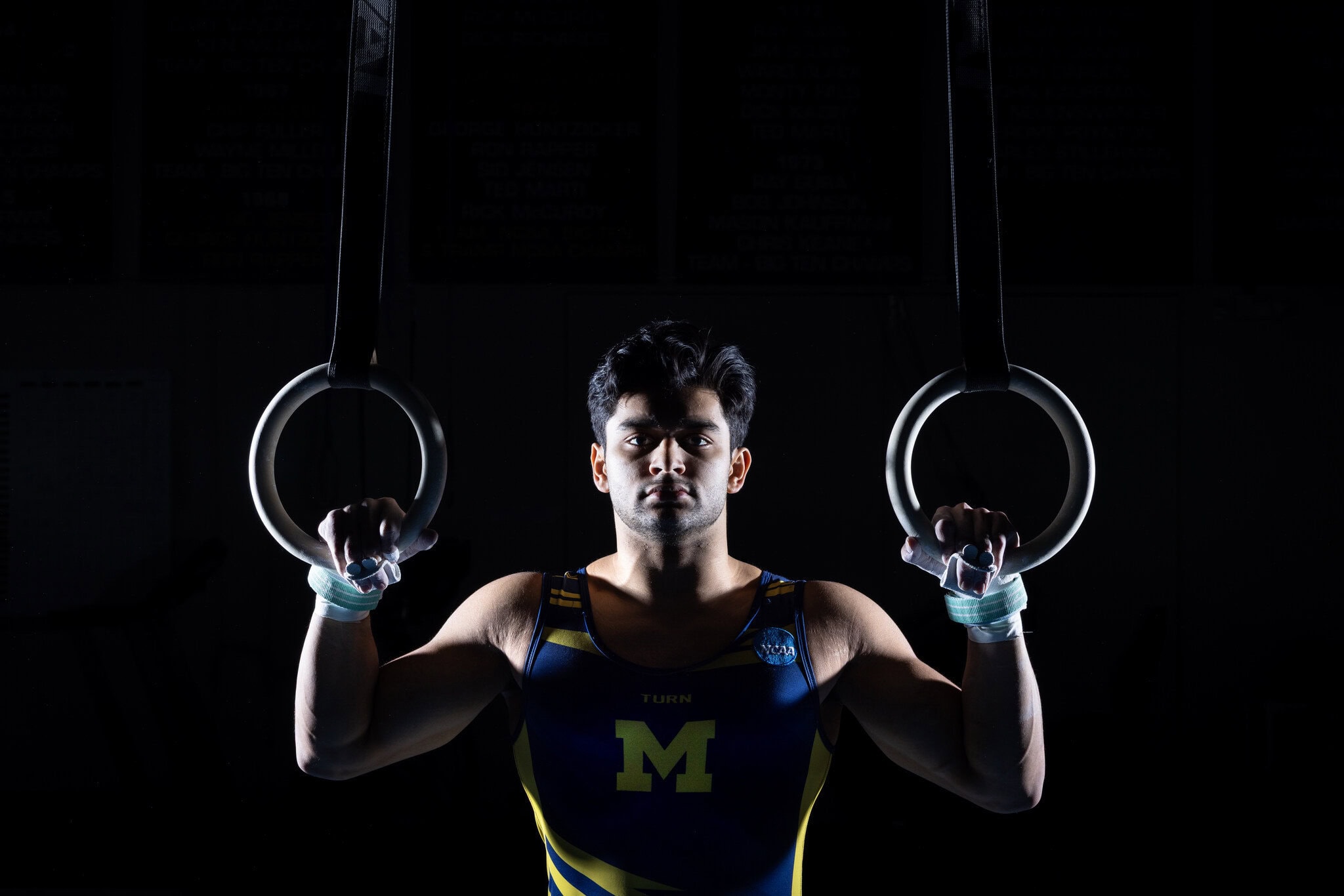
Rithik Puri dips his hands in a bowl with gymnastics chalk, rubs it on and claps, shaking off the excess. It’s a ritual he has performed thousands of times. And for the past four years, he has done it here, at The University of Michigan’s Newt Loken Training Center. The chalk will help absorb sweat and improve his grip on the still rings.
A biomedical engineering major, Puri is one of three engineering and computer science seniors on this year’s gymnastics team. Nearby, Logan McKeown, a computer science major, practices circles on the pommel horse, his arms alternating support as he travels from end to end. On the floor, Lais Najjar, also a computer science major, lands a dramatic opening tumbling pass—a high-flying double layout.
This gym is where the magic happens. It’s here—not under the arena lights—where competitions are truly won or lost. Every afternoon, a group of dedicated Michigan gymnasts push their bodies and minds to the limit. Training is a demanding blend of strength, flexibility, precision and mental focus. Each session begins with a thorough warm-up to prevent injury and prepare for the intense work ahead. From there, athletes move into targeted drills on each apparatus—floor, rings, pommel horse, vault, parallel bars and high bar.
One of four brothers, Rithik Puri grew up in Chicago and began gymnastics at age five. “As long as I can remember, my childhood was school and gymnastics,” he says. “My older brother had been doing gymnastics at a club, and his coach had this funny habit—when he would see the younger siblings come to pick up the kids on the team, he would point to them and say, ‘When do I get that one?’” In the end, all four Puri brothers ended up training at the same gymnastics club. “This was easier for my parents, because they only had to drive you to one place,” Puri laughs.
Three of the brothers would go on to train at Michigan. The fourth had his recruitment derailed by a wrist injury, but he has stayed close to the sport. These days, he serves as a Program Assistant and practice judge for the NCAA team.
It was Rithik Puri’s oldest brother who introduced him to biomedical engineering. Puri chose the major because of the problem-solving and critical thinking it requires. There’s a natural synergy between engineering and gymnastics: both demand precision, discipline and analytical thinking.
“Currently, roughly one-third of the 25 team members are engineering students,” estimates head coach Yuan Xiao. He believes the sport’s emphasis on physics, hard work and incremental improvement makes engineering a natural path for gymnasts.
That connection is clear in Puri’s academic path. As an undergrad, he studied orthopedic implants in design courses. “We were looking at these devices and trying to figure out ways, either biologically or mechanically, to improve their performance,” Puri explains. “I really love that aspect of engineering. It’s constantly iterative—trying to improve something over time.” The same mindset, he says, applies to gymnastics, where athletes are always refining their performance.
From Floor Routines to Data Structures
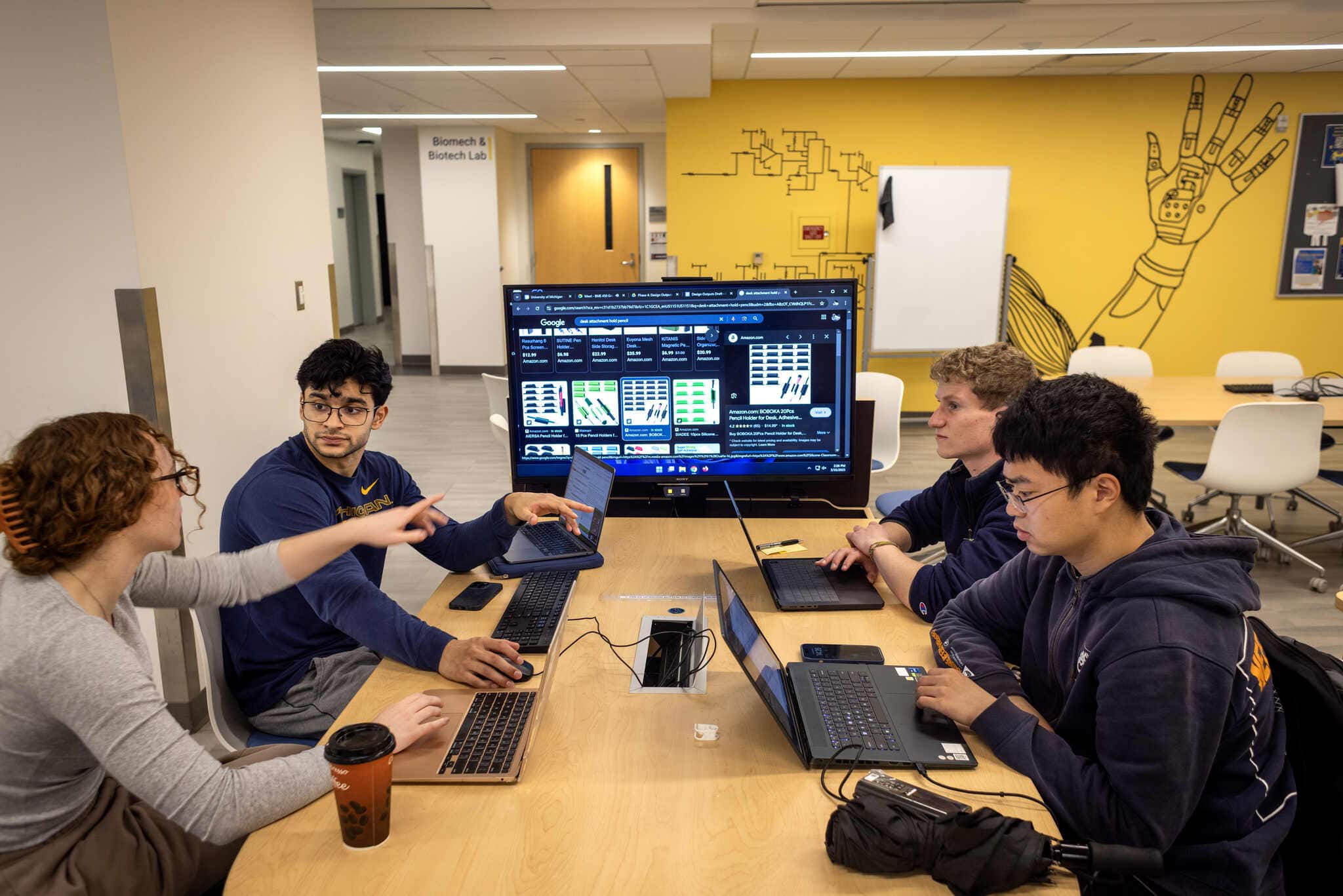
Fellow senior and team co-captain Lais Najjar also embraced both athletic and intellectual aspirations at U-M. “Even though I’m really ambitious athletically, academics is also a huge part of my life,” he said for a story published by the Computer Science and Engineering department, “Michigan was the best place for me to juggle those two passions.” In addition to his regular coursework, Najjar serves as an instructional assistant for EECS 281: Data Structures. Now finishing up his final engineering classes, he spends his remaining time writing code for and managing The Dublease, a company he co-founded with a fellow gymnast, friend, and U-M Electrical and Computer Engineering alum Alan Gerdov. The Dublease provides a digital platform to support students looking to sublet apartments in Ann Arbor and beyond. Gerdov and Najjar, both sons of immigrants, met when Najjar was a freshman and Gerdov was a senior. Gerdov’s parents came to the U.S. from Ukraine and Najjar was born in Syria.
Najjar and Puri first met while training at the same club in Chicago. That training and the time at Michigan helped propel Najjar to a remarkable milestone—competing at the 2024 Paris Olympics for his homeland, Syria. “The experience was amazing,” says Najjar, “but the biggest takeaway for me was seeing how proud my parents were when I was on that stage.”
Najjar sees two reasons for the strong representation of engineering students on the team. First, the team’s supportive culture encourages gymnasts to challenge themselves in and out of the gym. “When I was a freshman, we had a lot of engineering students on the team, and people got the strength to study what they wanted when they saw other people do it,” he says. Second, there’s the technical nature of the sport itself. “If you really want to understand a skill or performance on a much deeper level, you’re often going back to physics, mechanics, and how the body’s moving.”
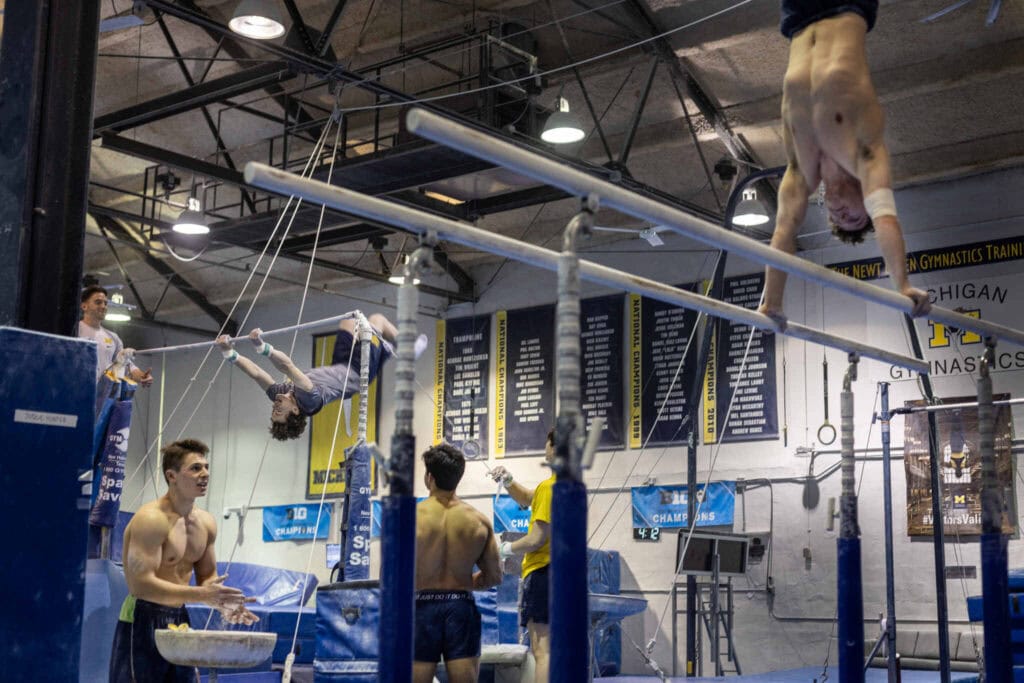
The same draw to challenge is what led Logan McKeown to study computer science. “If you go out there and do the hardest thing you can, it’s going to teach you the most and you’ll be able to apply that to anything you choose,” McKeown says. For him, structure and consistency are key. “A lot of successful people in school aren’t necessarily smarter, but they just believe in themselves a little bit and they’re structured. I think that’s a big part of being successful. You need to have a consistent work ethic and you need that in gymnastics and in school.”
Both Najjar and McKeown are enrolled as computer science majors in the College of Literature, Science, and the Arts (LSA). The College of Engineering’s Computer Science and Engineering Department (CSE) administers the Computer Science programs for both engineering and LSA.
Final Exams, Final Routines, Ultimate Victory
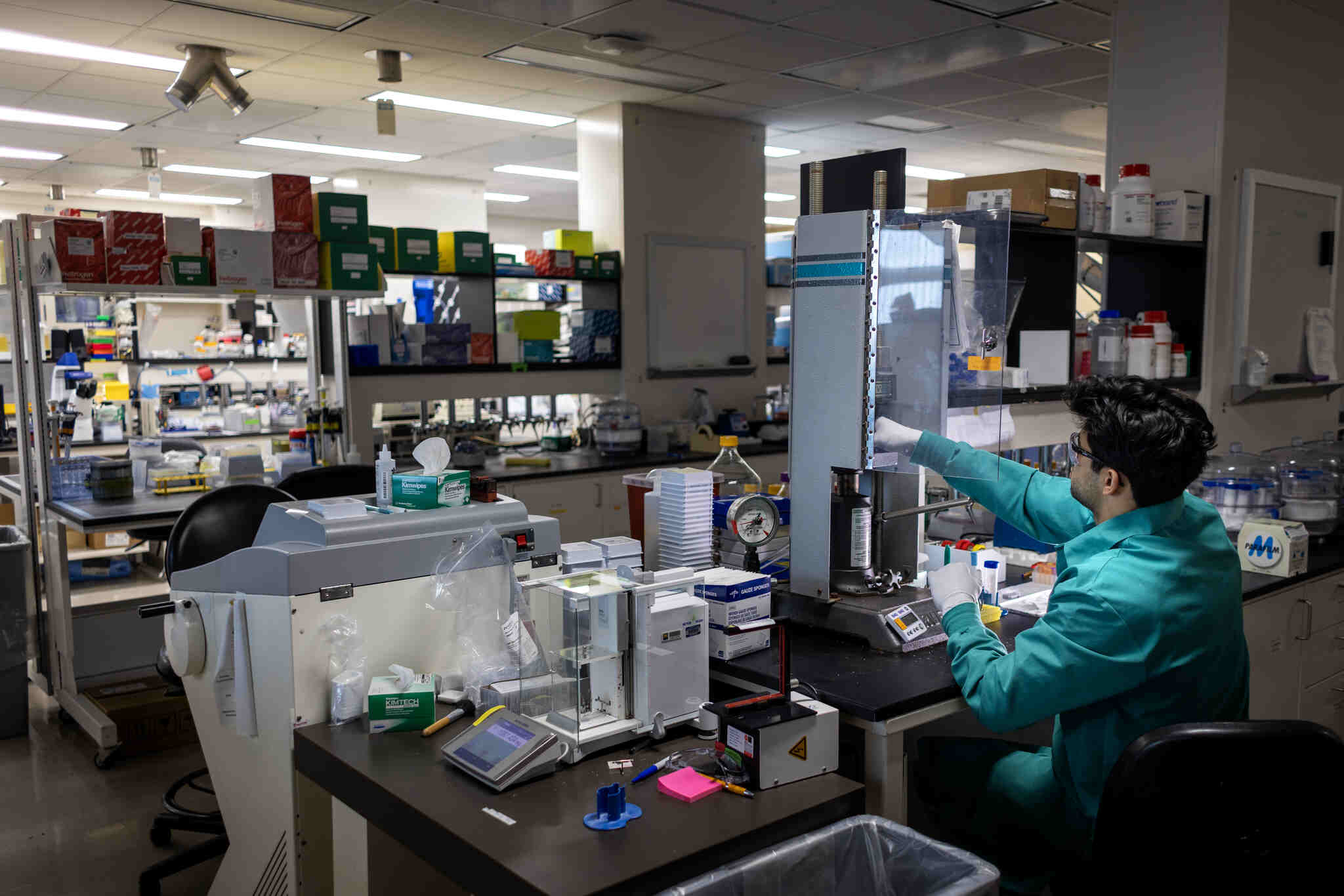
At Michigan, improvement comes through repetition, review and refinement. Gymnasts break down routines into individual elements, working tirelessly to perfect each motion. Coaches guide them through subtle adjustments—hand placement, body angle, timing—that can mean the difference between a good score and a great one. U-M student gymnasts train year-round and compete in meets against other schools during the winter and spring seasons. The Big Ten Championship and NCAA Championship are the two major annual competitions, both held in April, that mark the culmination of the collegiate gymnastics season.
Both 2025 championships took place in Ann Arbor. As the academic semester wound down, engineering seniors were attending their final classes, studying for exams and preparing for graduation—all while putting the final touches on the performances they would showcase at the Crisler Center. In the end, Puri and McKeown qualified to represent the U-M team at the Big Ten Championship and went on to compete at the NCAA Championship.

The No. 3-ranked U-M Men’s Gymnastics team captured its fifth consecutive Big Ten Championship on April 4. The Wolverines finished with a score of 330.750—their second-highest team score of the season. USA Olympians Paul Juda and Fred Richard led the way, but Rithik Puri was close behind with a 13.600 on still rings. On parallel bars, McKeown placed in the top 10 with a score of 14.150.
By the time the NCAA Championship arrived on April 19, the University of Michigan team was already ranked second in the nation. After a harrowing battle with Stanford, they went on to secure their seventh NCAA title—and their first national championship since 2014. Rithik Puri scored 13.966 on still rings, missing his season high by just 0.034 points. Logan McKeown contributed with a wonderful performance on parallel bars. Once again, Paul Juda and Fred Richard led the team.
“I was overwhelmed. I was grateful, and I felt so much joy that we finally accomplished what we set our minds to five years ago—and kept falling short of: winning an NCAA Championship,” Puri said. “That win went from a goal, to a dream, and ultimately an obsession. So in the end, the strongest emotion was relief. All the sacrifice was worth it.”
In addition to claiming both the Big Ten and NCAA Championships, the men’s gymnastics team finished the regular season tied for first place with Penn State.
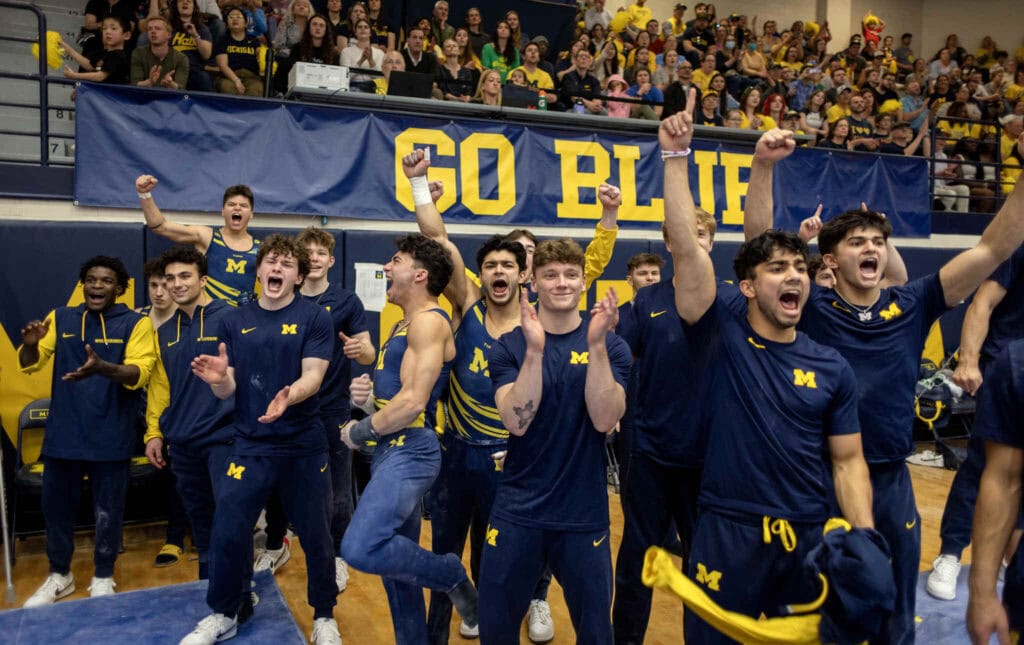
For Michigan gymnasts, success in both the arena and the classroom stems from the strong sense of community that defines the team. Seniors and juniors advise younger teammates, helping them navigate course loads and choose their majors. Engineering seniors don’t just train together—they move through their academic journeys side by side. They live together, study together and encourage one another through problem sets, projects and final exams.
That spirit of solidarity and mutual support is unmistakable—whether it’s in the gym, where teammates pause their own routines to cheer on others vying for Championship spots, or in the arena, where gymnasts lock arms, tense with focus, eyes fixed on one of their own performing under pressure. “Community is everything to us,” Puri said. “We moved as one. We trained for each other, and that foundation is what helped us bring the trophies home. The only thing better than winning the trophy was handing it off to another brother.” It’s that deep sense of belonging—a true brotherhood—that Puri, McKeown and Najjar say they’ll miss most when they graduate this May.
